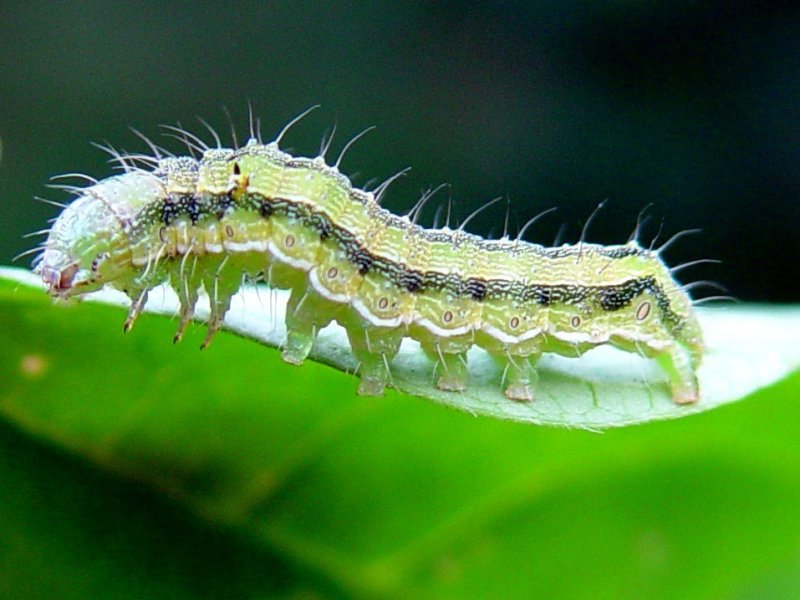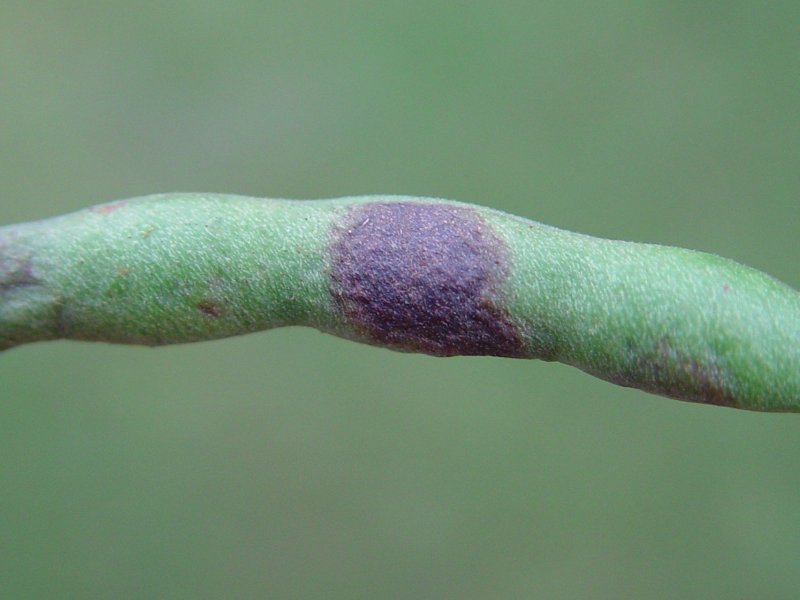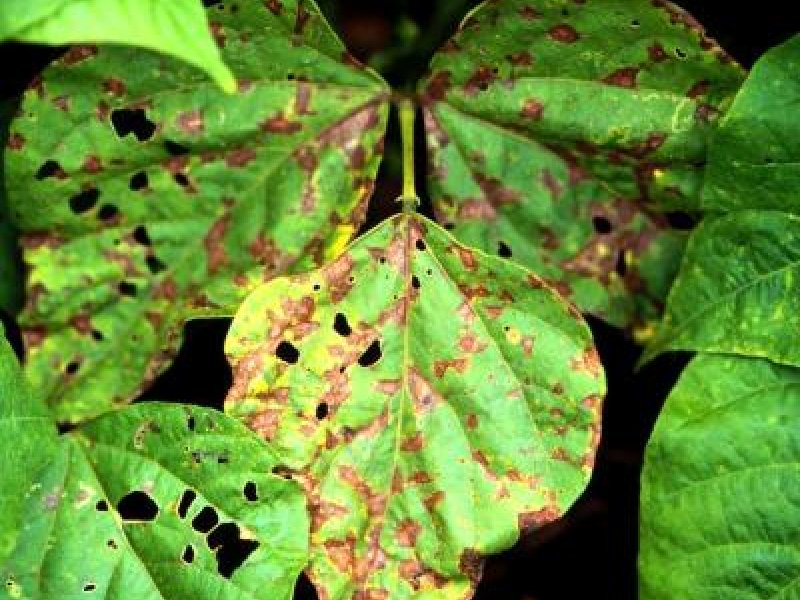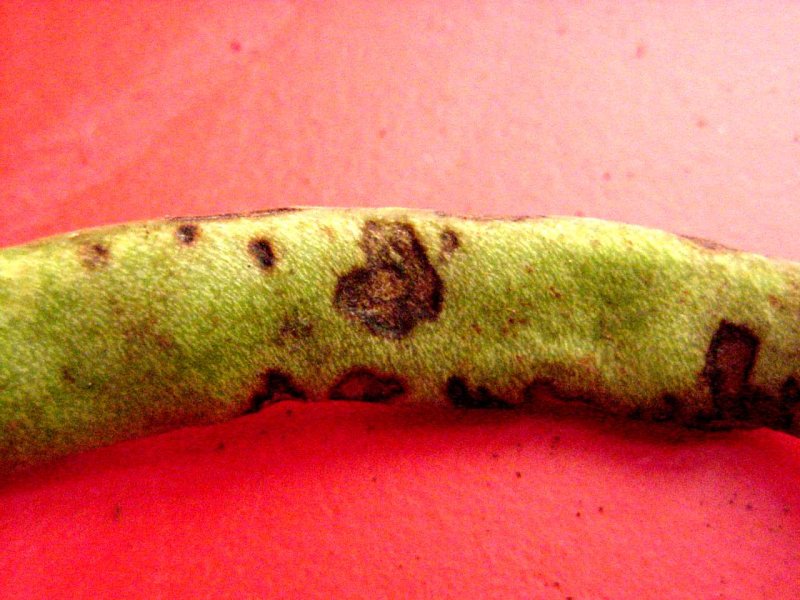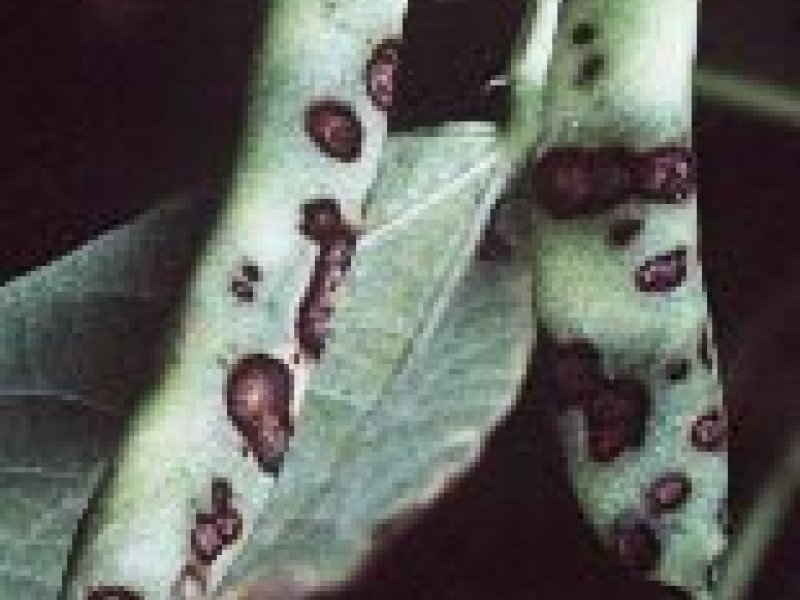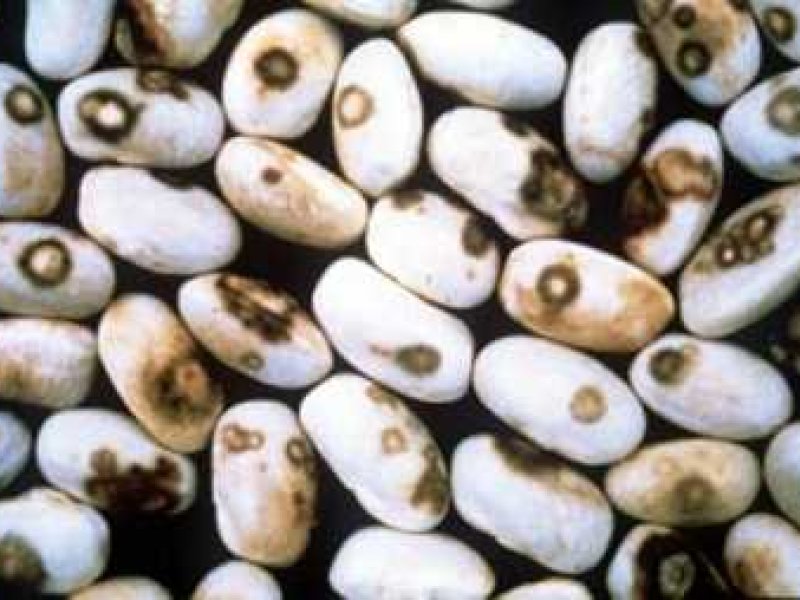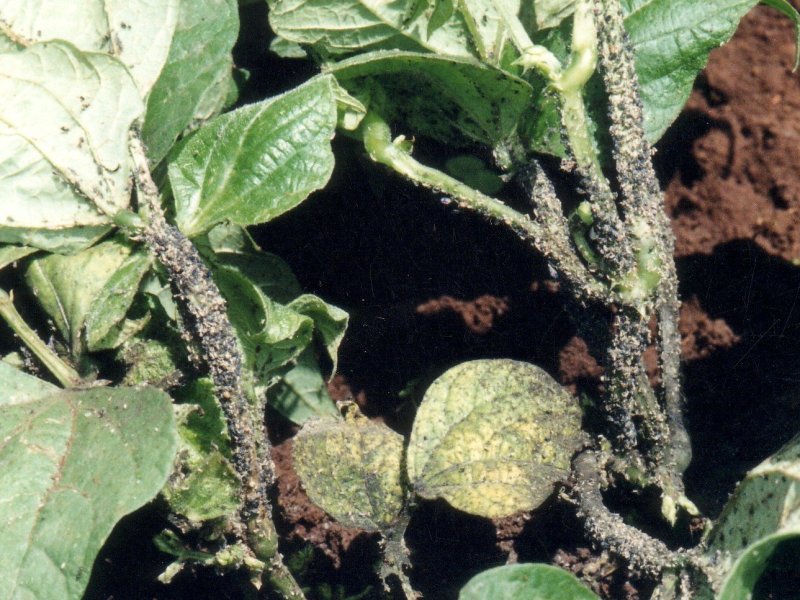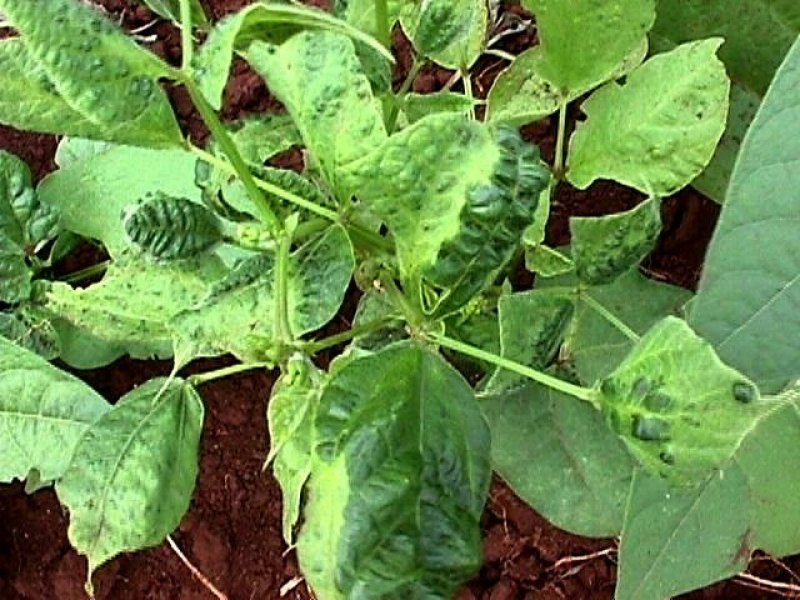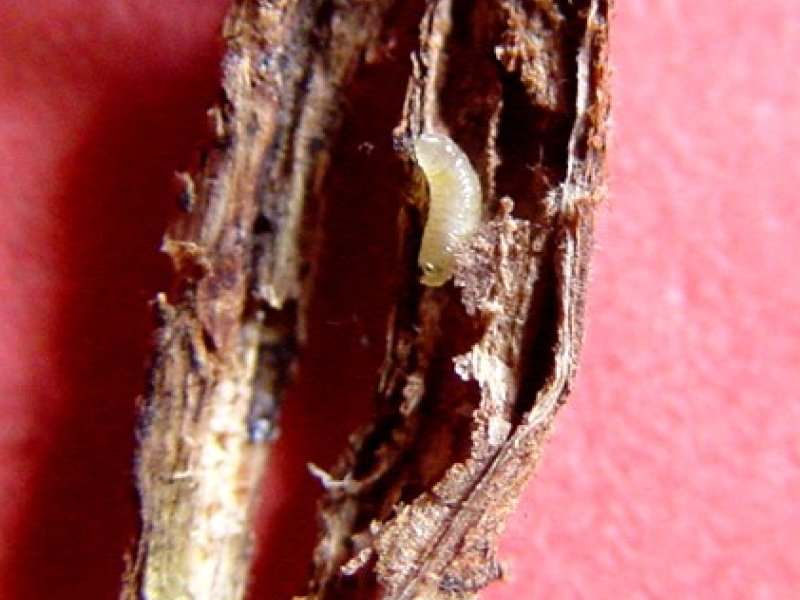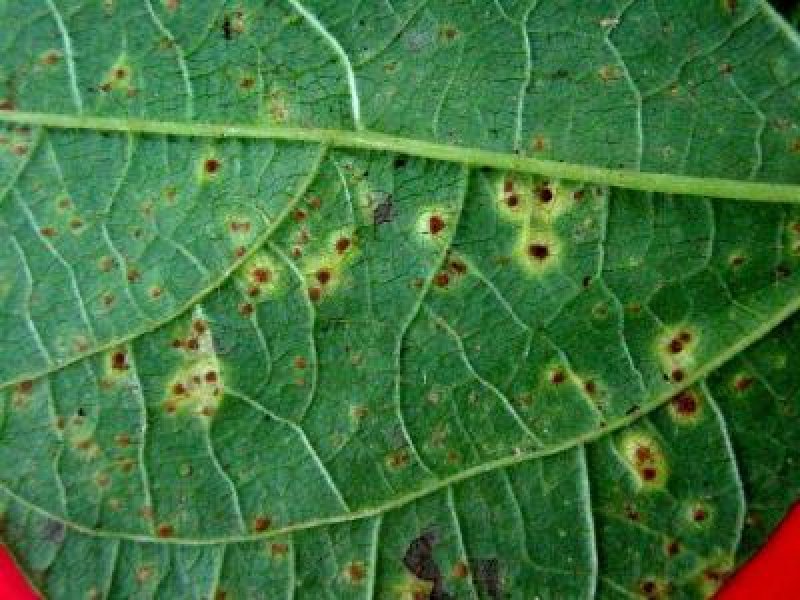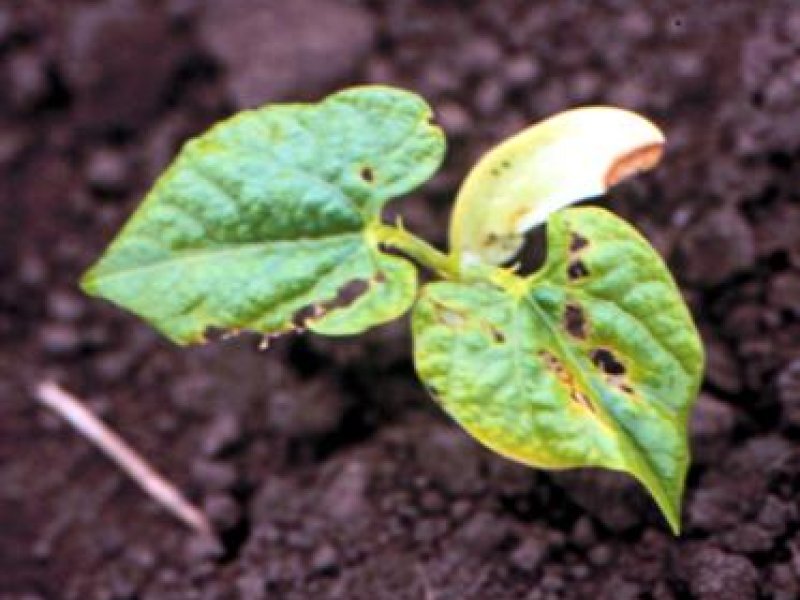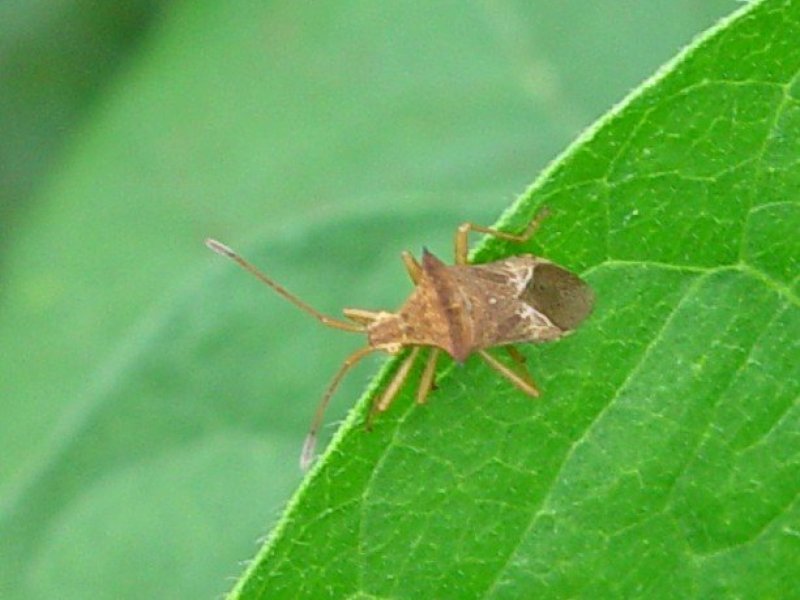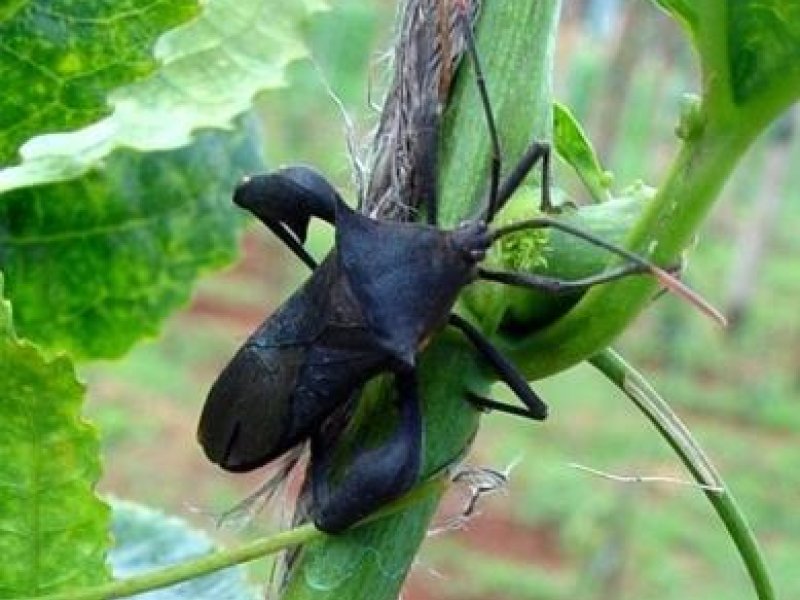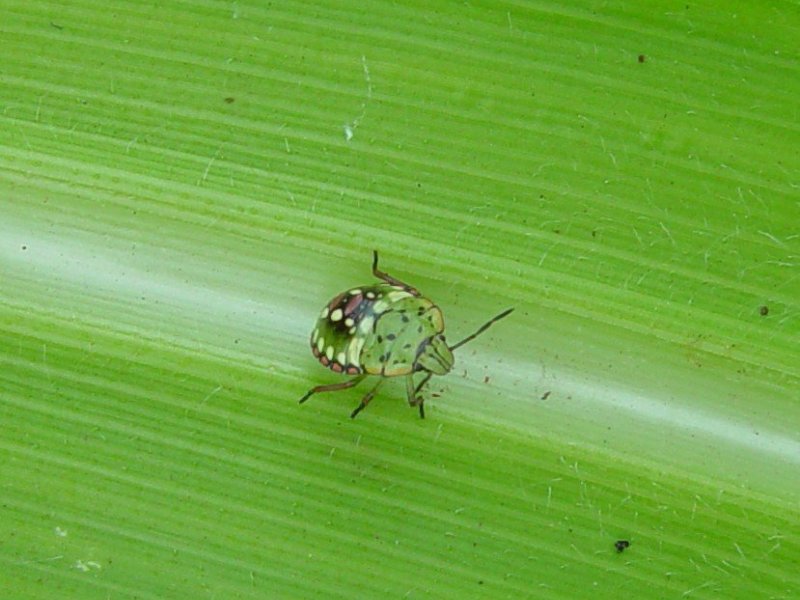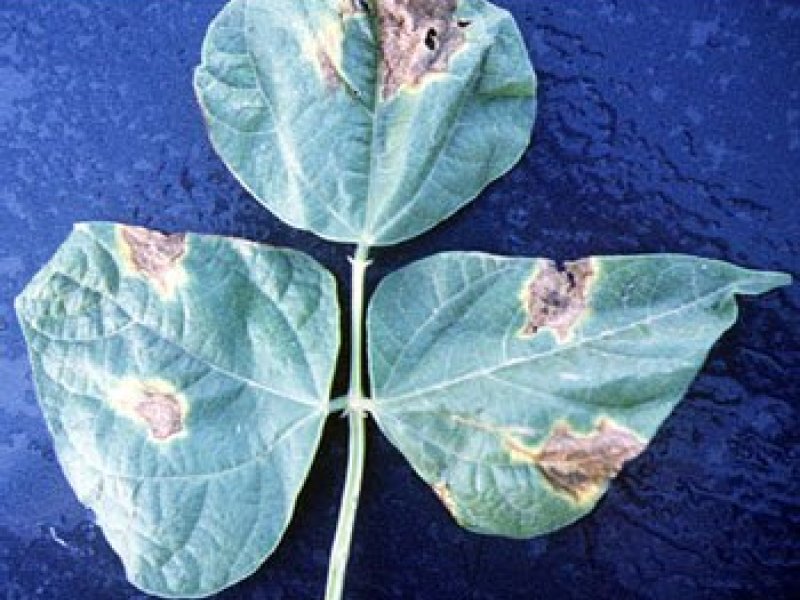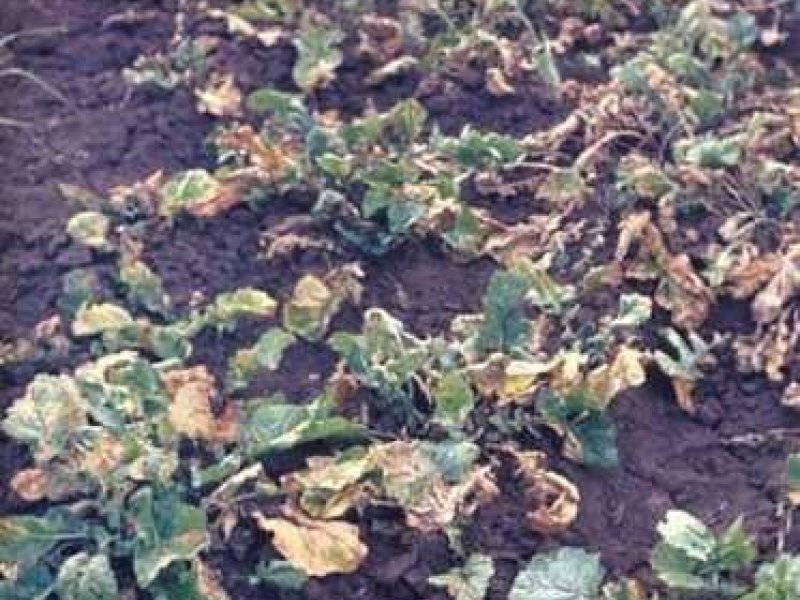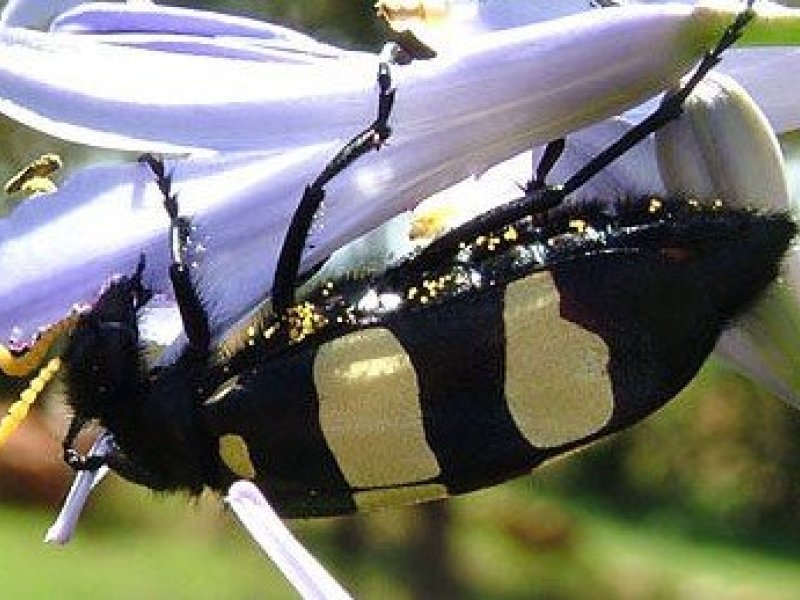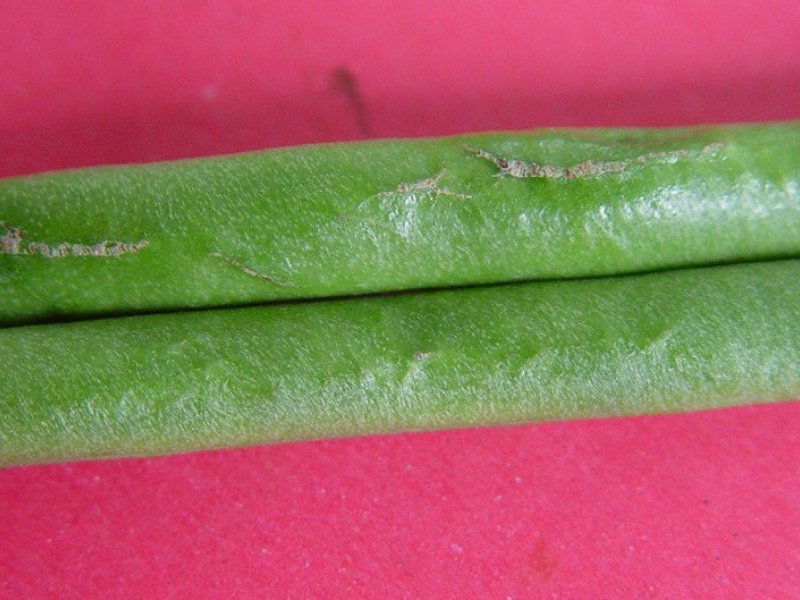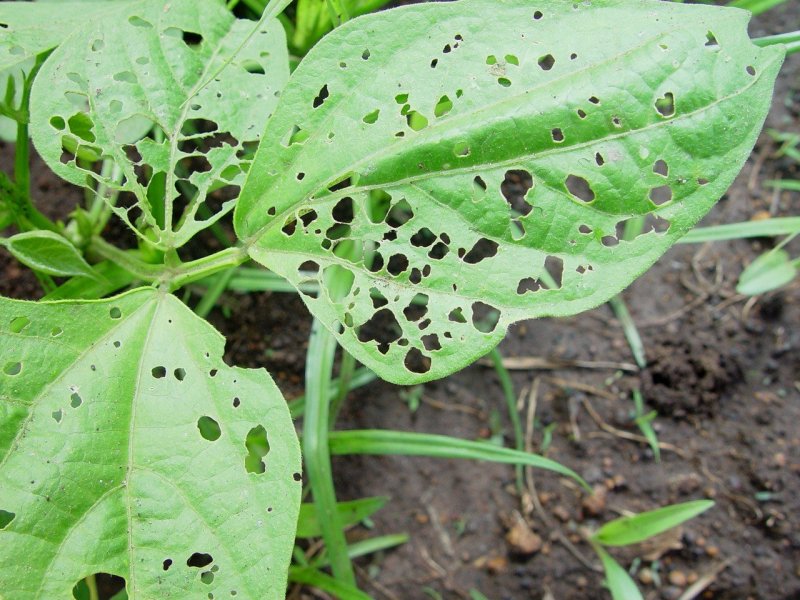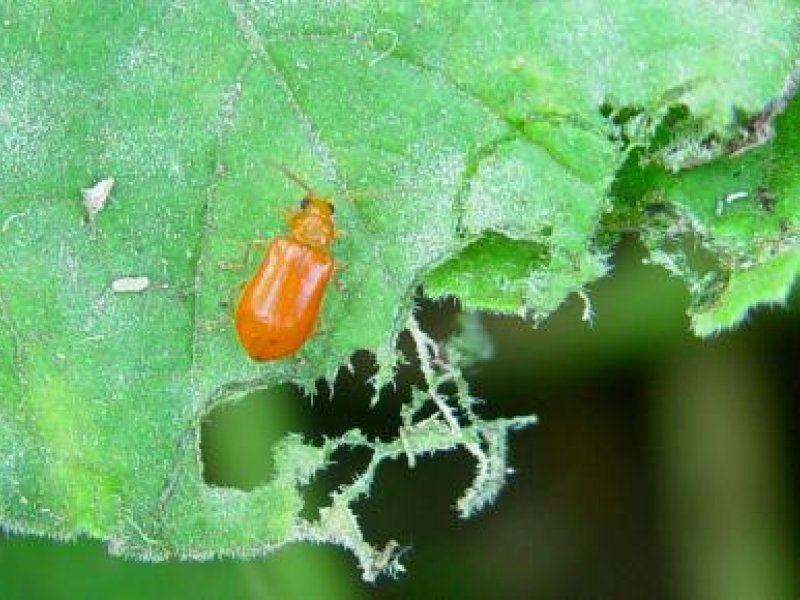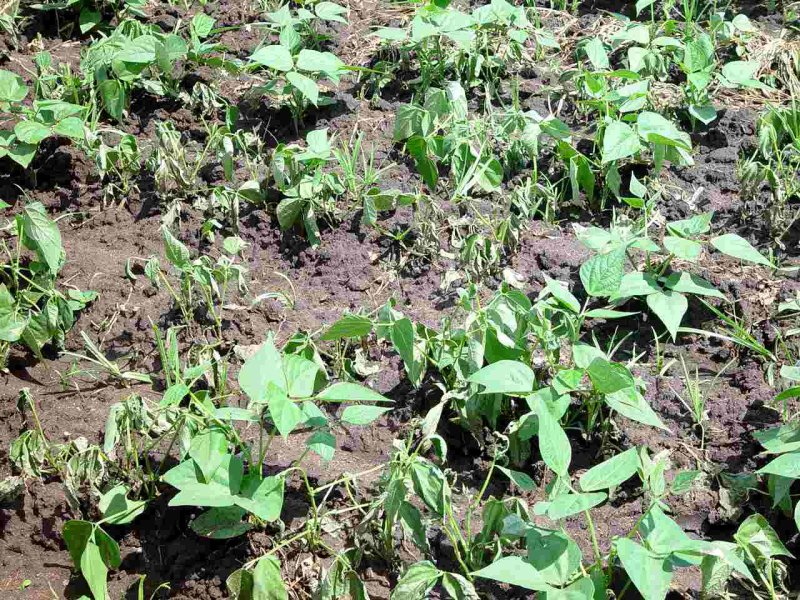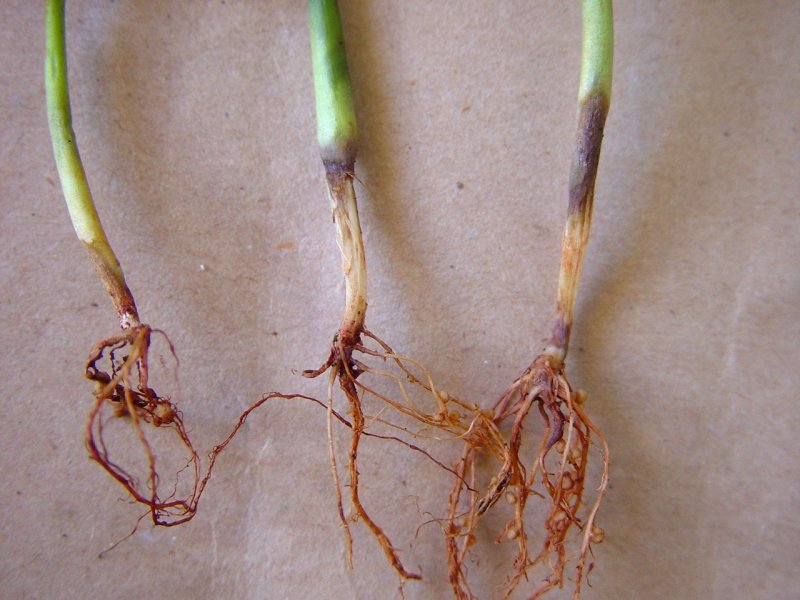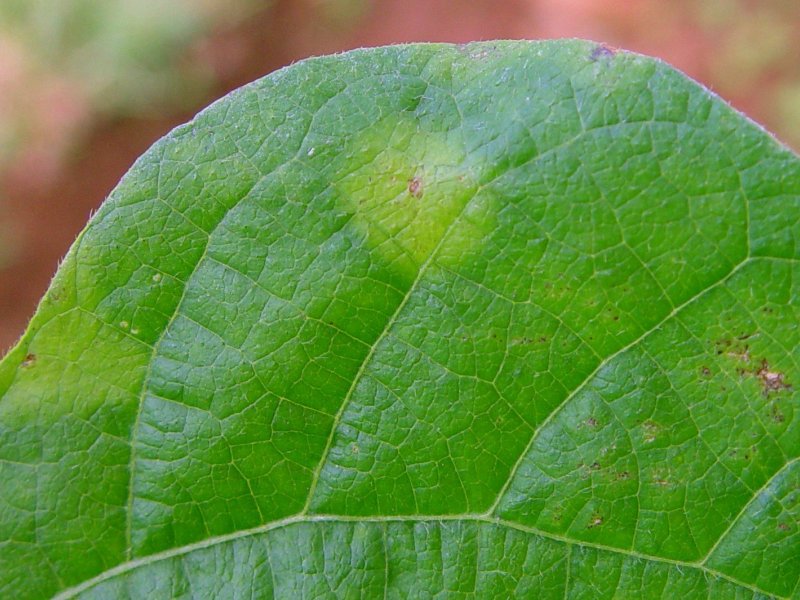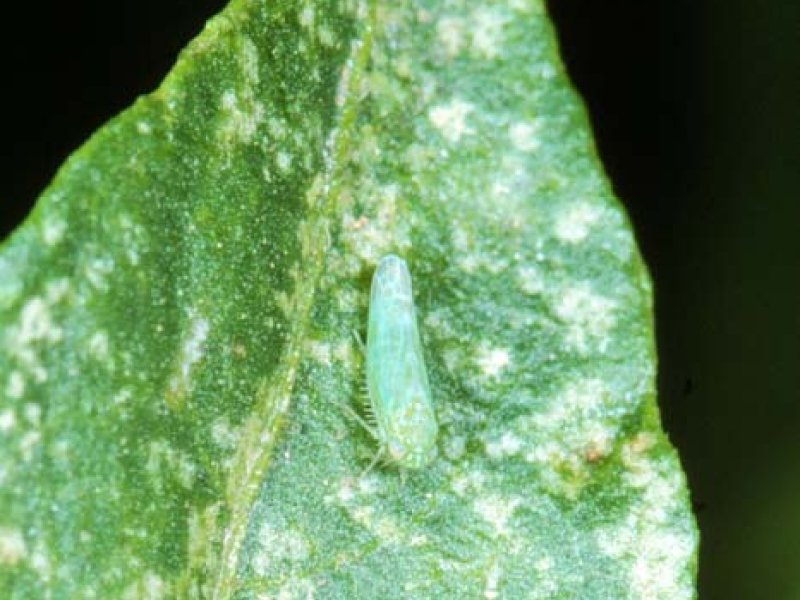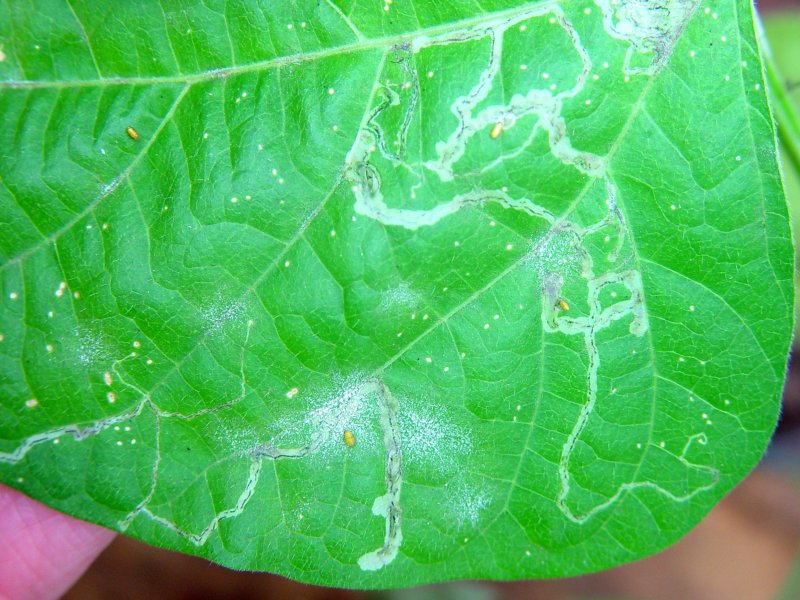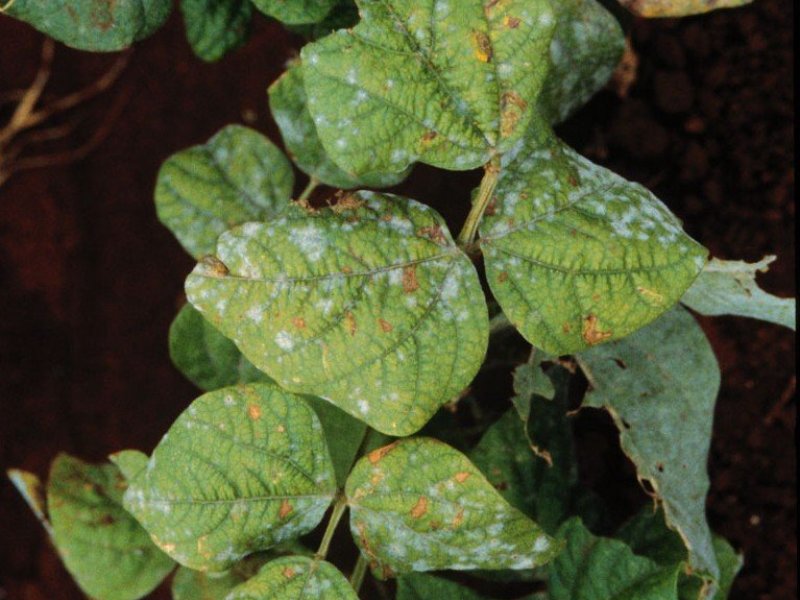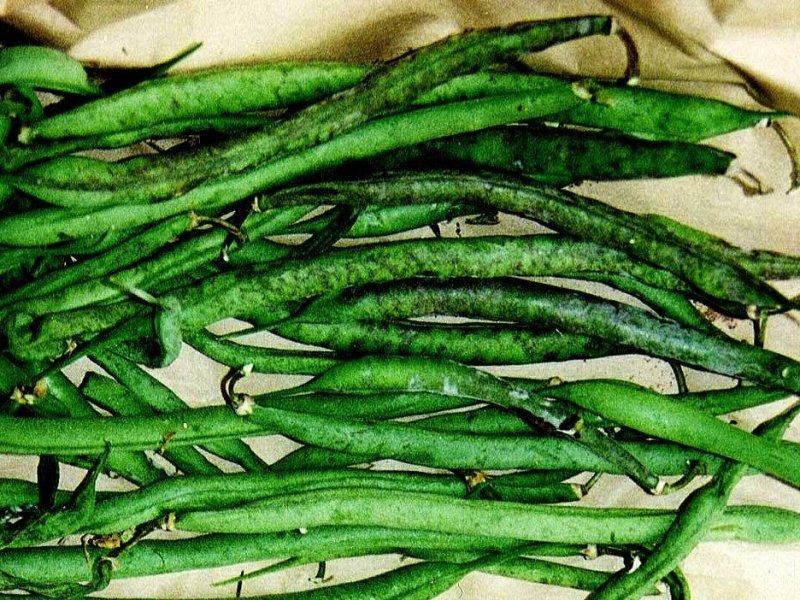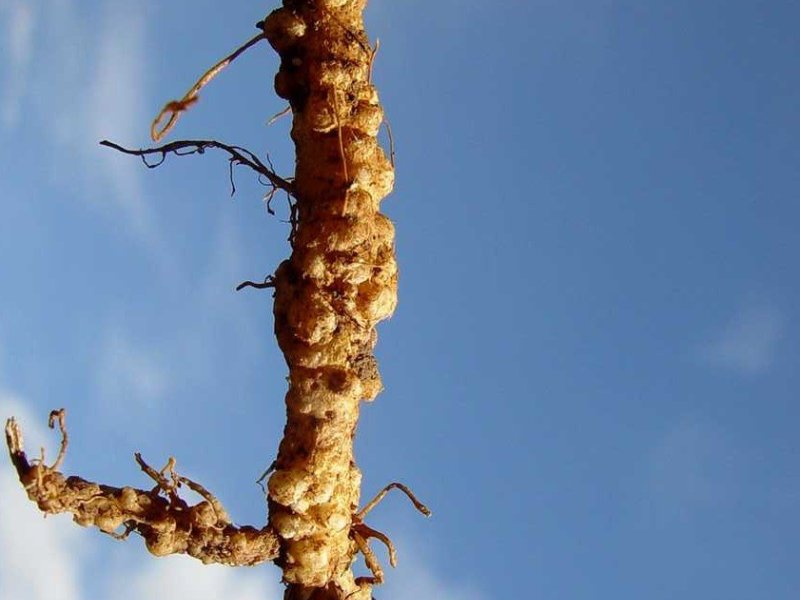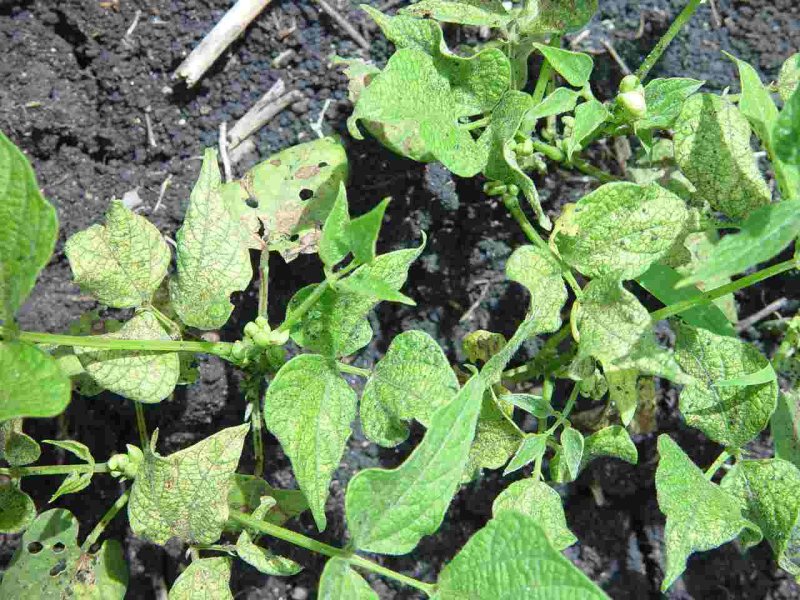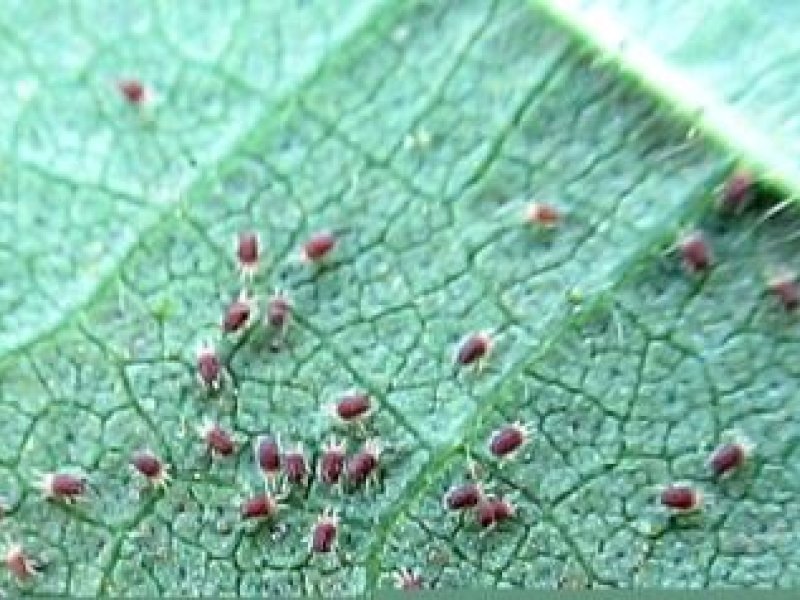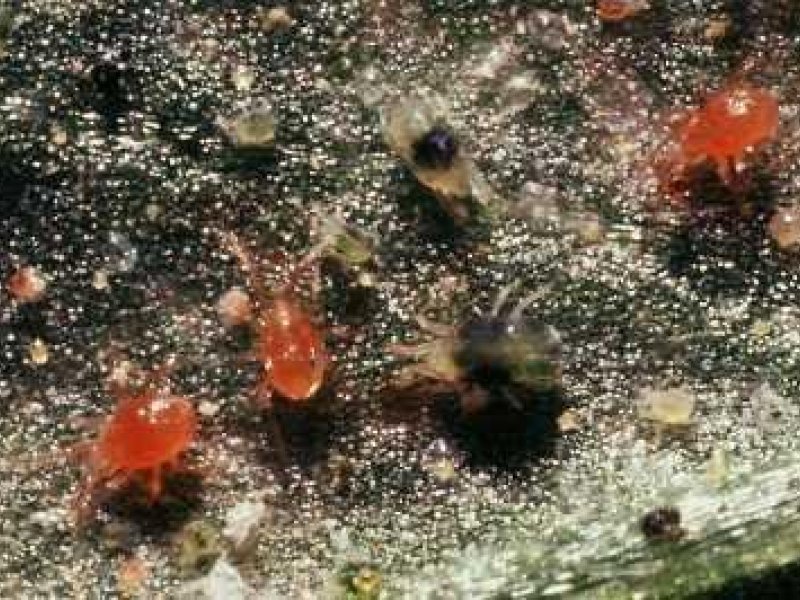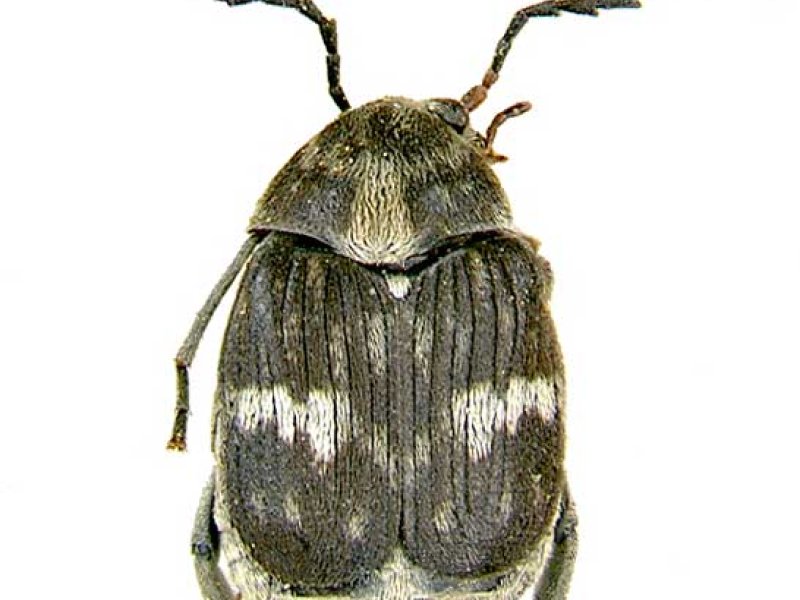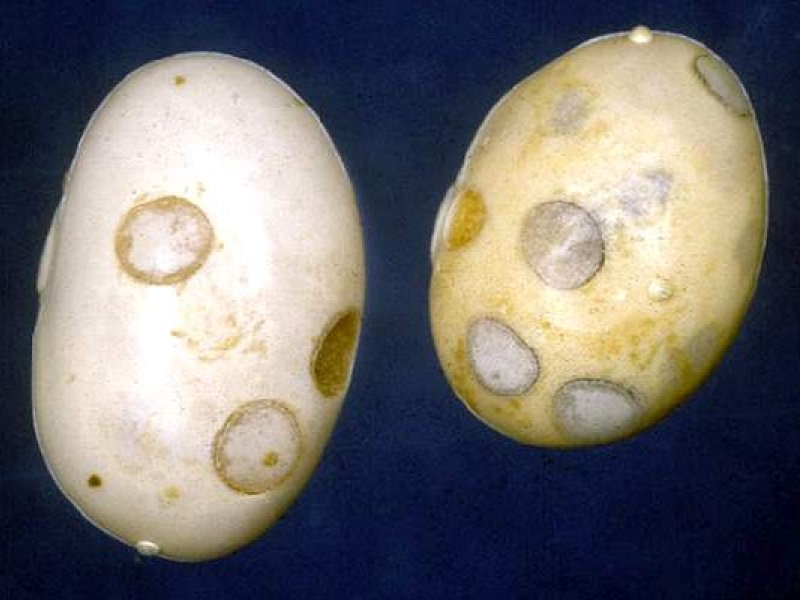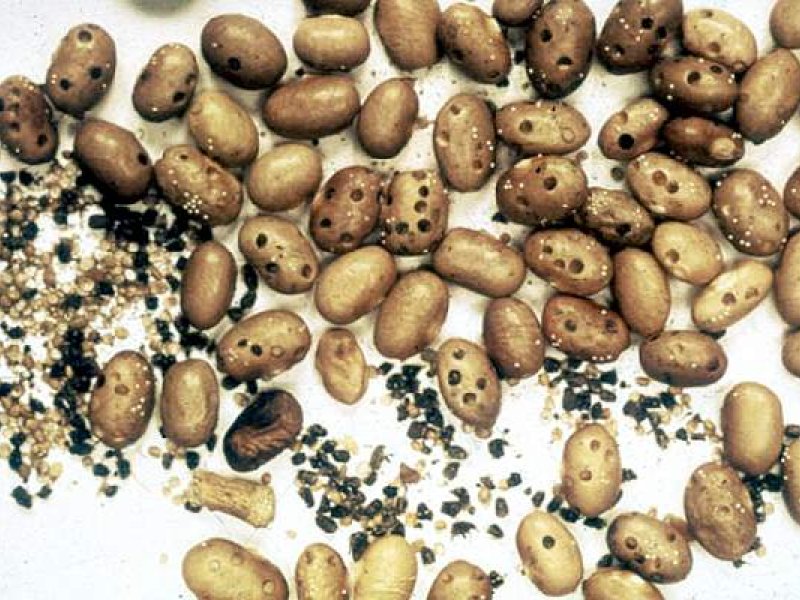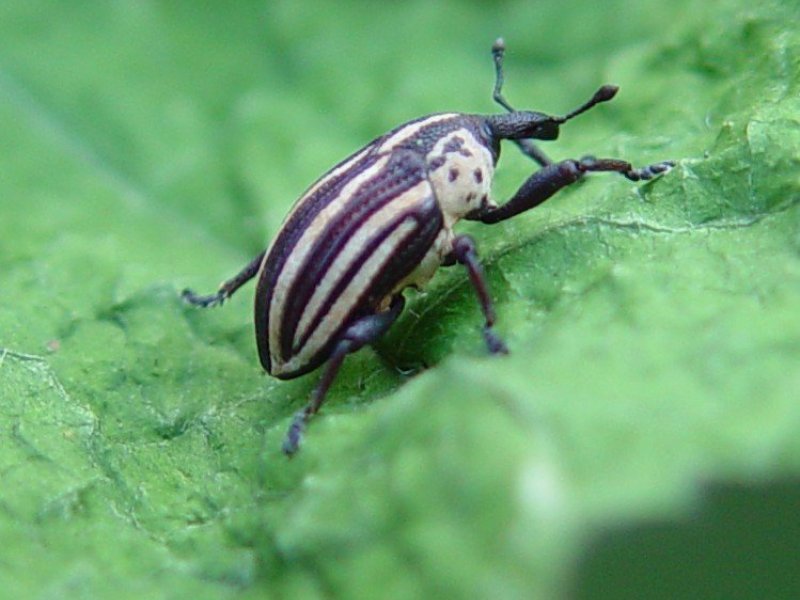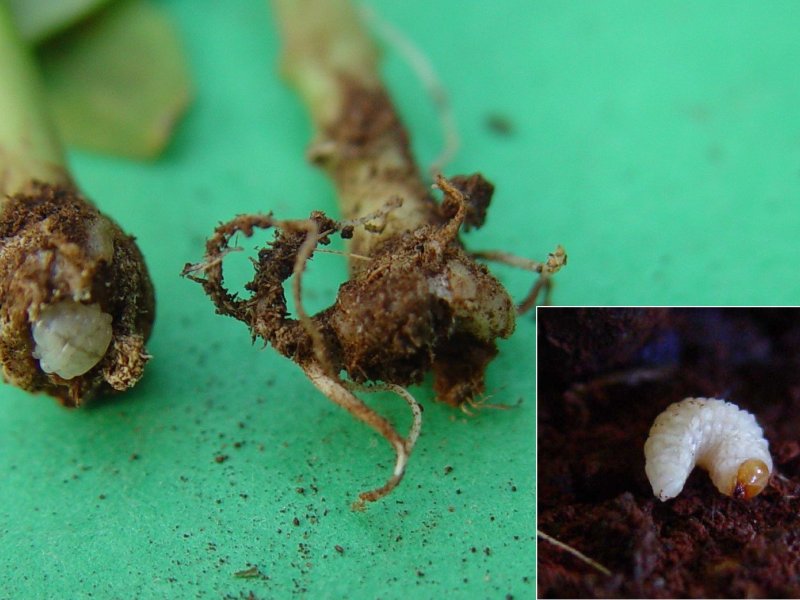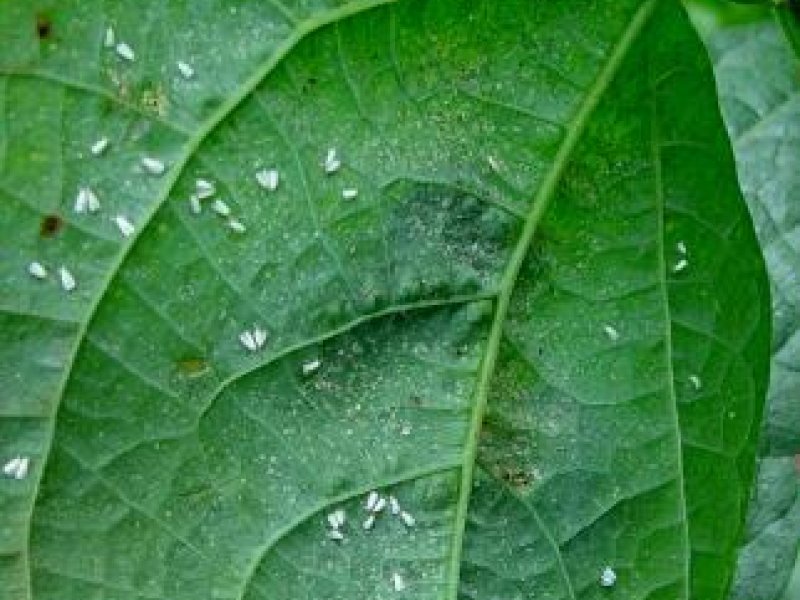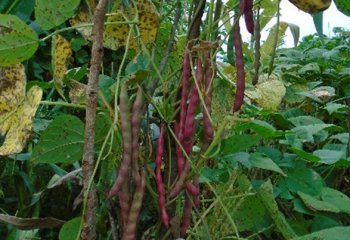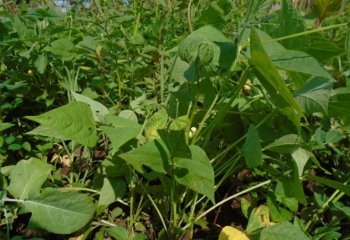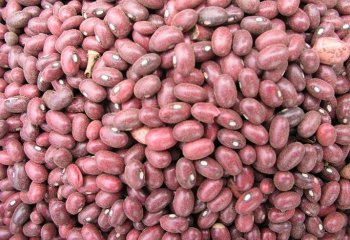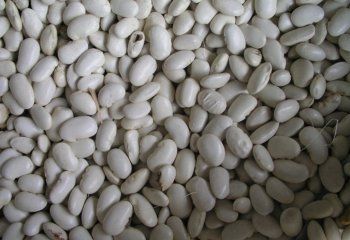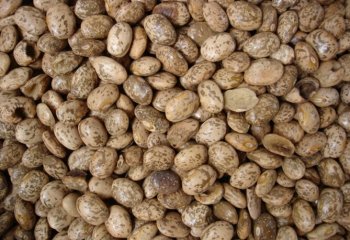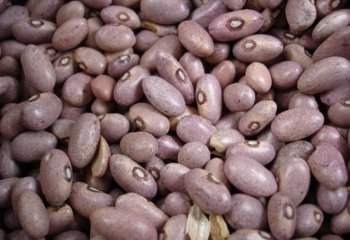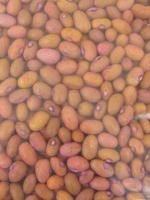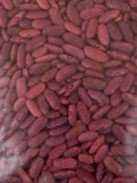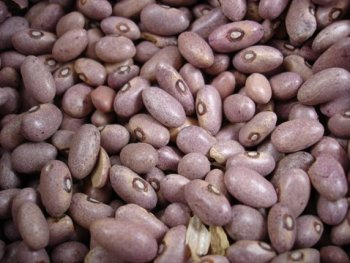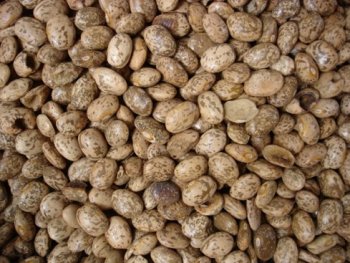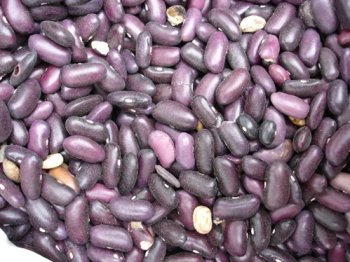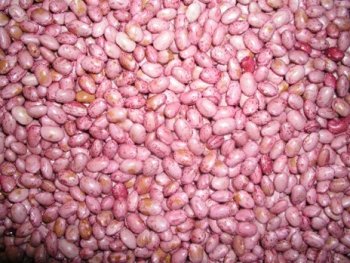|
African bollworm and other pod borers Several caterpillars are important pests as pod borers in common beans and French beans. The most common are the African bollworm (Helicoverpa armigera) and the legume pod borer (Maruca testulalis). They feed on leaves, flowers, pods and seeds. The African bollworm caterpillars are 3 to 4 cm long. They make clean circular holes in the pods. One caterpillar may damage several pods. Caterpillars of the legume pod borer attack pods at the point of contact with other pods, leaves or the stem. They frequently web together flowers, pods and leaves with excrements.
Pod borers usually do not cause significant yield reduction in beans. However, they are quarantine pests, and are particularly important in French beans grown for export. If only 1 caterpillar is found in a consignment sent to Europe, the whole consignment may be rejected. If pod borers are found in a field, the beans harvested should be sorted very thoroughly to remove the bollworms manually.
|
|
|
What to do:
|
|
Angular leaf spot (Phaeoisariopsis griseola) Symptoms consist of small dark brown spots with angular edges and are often numerous to give the foliage a checker-board appearance. The spots may increase in size, join together, and cause yellowing and necrosis of the affected leaves. This may lead to premature defoliation. When humid, the fungus produces a grey mould on the lower surface of the spots. Infected pods have brown blotches. The disease is favoured by high moisture and moderate temperatures (20-25°C). The disease is seed-borne.
|
|
|
What to do:
|
|
Anthracnose (Colletotrichum lindemuthianum) Symptoms of anthracnose can appear on any plant part. Pale brown sunken spots may appear on the cotyledons of infected seedlings. Water may spread the disease to the hypocotyl, which if girdled, kills the seedling. Lesions on leaves are dark brown. They are restricted to the veins on lower leaf surface. On stems, lesions are elongated and sunken. On the pods, the fungus produces black, sunken lesions. These lesions penetrate deep into the pods and may cause shrivelling of the young pods. Infected seed become discoloured changing to yellow through brown to black. In damp weather, the centres of anthracnose lesions become covered with a pink spore mass. The disease is seed-borne. |
|
|
What to do:
|
|
Aphids (Aphis fabae) and (Aphis craccivora) The black bean aphid (Aphis fabae) and the black legume aphid (Aphis craccivora) are black to dark brown brownish in colour and winged or wingless and vary in size from 1.5 to 3.0 mm. Aphids feed by sucking plant sap. Small aphid populations may be relatively harmless, but heavily infested plants usually have wrinkled leaves, stunted growth and deformed pods. Plants, in particular young plants, may dry out and die under heavy aphid attack. Heavy attack on older plants may cause crop loss by decreasing flower and pod production. Damage may also reduce seed viability.
In addition, plants may become contaminated by honeydew produced by aphids and sooty mould growing on honeydew. French beans contaminated with honeydew and / or sooty moulds are not marketable. Aphids are also vectors of diseases, including the bean common mosaic virus. The black bean aphid is a widely distributed pest of beans. The black legume aphid usually attacks beans grown at low altitudes. |
|
|
What to do:
|
|
Bean common mosaic virus Symptoms of bean common mosaic virus (BCMV) are cupping and twisting of leaves with a light and dark green mosaic pattern. The dark green tissue is often bubbled and/or in bands next to the veins. Affected plants produce smaller, curled pods with a greasy appearance, and yields are reduced. The virus is seed borne. It can be transmitted by several aphid species. |
|
|
What to do:
|
|
Bean flies (Ophiomyia spp.) Bean flies also called bean stem maggots are serious pests in Africa. The adult is a tiny (about 2mm long) fly, shiny black-bluish in colour. The female fly pierces the young leaves to lay eggs and sucks the exuding sap. This leaves yellow blotches on the leaves, which are the first signs of bean fly attack and may serve as early symptom useful for monitoring the presence of this pest in the field. Maggots mine their way from the leaves down to the base of the stem, where they complete their development.
Maggot feeding destroys the tissue causing the stem to swell and split and reducing formation of lateral roots. Attacked plants produce adventitious roots in compensation. Maggots (yellow in colour) and pupae (brown or black in colour) can often be seen through the stem splits. Young seedlings and plants under stress wilt and die when attacked by bean flies. Older or vigorous plants may tolerate bean fly attack, but their growth will be stunted and their yield reduced. Damage is more severe in plants growing under poor conditions such as infertile soils and drought.
|
|
|
What to do:
|
|
Bean rust (Uromyces appendiculatus var. appendiculatus) Rust spots (pustules) appear on all parts above the ground. They are most numerous on leaves, particularly on the underside. They are less abundant on stems and occur sparingly on pods. Initial symptoms are minute, slightly raised yellow pustules, which later become distinct circles, reddish brown in colour and surrounded by a yellow halo. The disease is spread long distance by wind. Plant to plant spread of the disease is by farm tools, insects or water splash. Severely infected leaves drop off. |
|
|
What to do:
|
|
Bean seed fly (Delia platura) The bean seed fly, also known as seed corn maggot, resembles small houseflies. It is about 1cm long. Female flies are attracted to recently disturbed open soil, where they lay eggs, especially where there are plant residues or when large amount of manure has been applied. The maggots bore into germinating bean seeds or the cotyledons (first seed leaves) of the young plant eating them. This causes patchy emergence of seedlings. If damaged plants emerge, they are stunted, weak and fail to develop into productive plants. Pupation takes place in the soil, 2-4 cm under the soil surface. |
|
|
What to do:
|
|
Bugs Several species of bugs feed on beans. The most common in East Africa are the spiny brown bug (Clavigralla tomentosicolis), Riptortus bugs (Riptortus dentipes), the green stink bug(Nezara viridula) and the tip wilter (Anoplocnemis curvipes). Bugs suck on pods causing tiny lesions, and may cause shrivelling and rotting of the seeds, which lose viability. The whole pod may also shrivel. French bean pods showing signs of bug attack (pimples) are not marketable. Tip wilters sometimes suck the sap on shoots, causing them to wilt and turn necrotic and rot. The green stinkbug transmits a fungus to developing seeds, causing yeast spot, which is a widespread but a minor disease of beans in Africa. Bugs are difficult to control since they usually feed on a wide range of crops and are very mobile. |
|
|
What to do:
|
|
Common blight (Xanthomonas axonopodis pv. phaseoli) This disease is a constraint to bean production in Kenya. Crop losses of between 10 and 75% have been reported. The common blight produces similar symptoms on leaves, pods, stems and seeds. Small water-soaked spots are the first symptoms observed on leaves and appear within 4 to 10 days of infection. As the spots develop, the centre becomes dry and brown. The lesion is surrounded by a narrow band of bright yellow tissue. However, yellowed tissue is occasionally absent. |
|
|
What to do:
|
|
Cutworms Cutworms attack young seedlings. First instars are 0.7-1 cm, later instars are 3.5-5cm long. The caterpillar emerges from the soil at night, encircles the plant with its body and cut through the stem of young plants just above ground level. They may also damage the plants underground. Cutworm damage causes plants to wilt and die. Cutworm damage is usually minor and does not normally warrant control. However, in severe outbreaks a young crop may be destroyed. |
|
|
What to do:
|
|
Flower or blister beetles (Mylabris oculata) The adults of the flower beetles, also known as blister beetles, feed on bean flowers (petals and / or pollen) reducing pod set. The adults are medium to large sized beetles (2-5 cm in length), usually black and yellow or black and red in colour. The immature stages (larvae) do not feed on plants. They live in the soil and eat grasshopper eggs. |
|
|
What to do:
|
|
Flower thrips (Frankliniella spp. and Megalurotrhips sjostedti) Feeding by flower thrips causes scars and blemishes on leaves and pods. Flower thrips can be found feeding on young plants. They are less than 2 mm long. As soon as the plants start flowering, however, most thrips would be found in the flower buds, flowers and on the young pods. Heavy thrips feeding causes flower abortion and flower malformation. French bean pods become scarred (having a rough silvery surface) and malformed and are not marketable. |
|
|
What to do:
|
|
Foliage beetles (Ootheca spp.; Monolepta spp.) In East Africa foliage beetles (Ootheca spp.; Monolepta spp.) are commonly found feeding on bean leaves. Foliage beetles chew small round holes in the leaves. They are about 4-7mm long. They may be a serious problem when present in large numbers or when attacking young plants. Heavy attacks may cause defoliation. Attack on young plants may reduce plant vigour, plant size and yield. The problem is more acute in fields with continuous growing of beans.
Ootheca beetles are normally not serious pest of French beans, but are an important pest of common beans in East Africa. The larvae (grubs) of foliage beetles live in the soil feeding on roots. Their feeding may cause stunted growth and premature ageing of the plants.
Grubs of weevils live in the soil feeding on roots or may bore into the stem of the bean plant causing swellings or galls, as is the case of the striped bean weevil. Plants attacked by grubs of this weevil show stunted growth and may die. The stem of the plant breaks easily during harvesting (see more below). |
|
|
What to do:
|
|
Fusarium root rot (Fusarium solani f. sp. phaseoli), Fusarium wilt Seedlings infected with Fusarium root rot appear dwarfed. The primary leaves are often yellow, later turning necrotic and finally the seedlings wilt. Fusarium species infect bean roots when the soil is too wet, or too hot for good bean growth. The fungus survives in soil for long period. |
|
|
What to do:
|
|
Halo blight (Pseudomonas syringae pv. phaseolicola) The most characteristic halo blight symptoms occur on bean foliage. Initially, small water-soaked spots resembling pin pricks appear on the lower leaf surface. These spots turn brown in a few days, and the surrounding tissue gradually become yellow-green. This zone of yellowed tissue around the spot resembles a halo, hence the name of the disease. Pod lesions first appear as small water-soaked pin pricks on the pod surface. These lesions gradually enlarge to form dark sunken spots of various sizes. A whitish bacterial ooze appears on the spots when wet. Halos do not develop around pod lesions. Pod lesions are especially important to the French bean industry because they make the bean pod unacceptable to fresh market and processors. On dry beans, pod lesions are of less importance because the beans are shelled before marketing. When infected seed is used, the primary leaves of seedlings show interveinal chlorosis, suggestive of mosaic virus infection. |
|
|
What to do:
|
|
Leafhoppers (Empoasca dolichi and E. lybica) They are widely distributed in Africa. Leafhoppers are small (about 2.5 mm long), slender mobile insects and green in colour. They move sideways when disturbed. Numerous leafhoppers may be seen on the underside of leaves. Their feeding on beans causes down curled leaves with yellowish margins. Eventually the whole plant may turn yellowish brown and dry-up. In Africa, leafhopper damage is usually minor and does not warrant control. |
|
|
What to do:
|
|
Leafmining flies (Lyriomiza spp) Leafminers are small flies, about 1.5 mm in length. The maggot makes long, slender, white mines (tunnels) in leaves.
Severely mined leaves may turn yellow and drop. Severely attacked seedlings are stunted and may eventually die. Control measures are necessary when attack is severe, especially on young plants. |
|
|
What to do:
|
|
Powdery mildew (Erysiphe polygoni) A white powdery mould appears on the upper leaf surfaces. Severely diseased leaves turn yellow and die. Leaf petioles, stems and pods can also be affected. |
|
|
What to do:
|
|
Root-knot nematode (Meloidogyne incognita, M. javanica) They cause stunting and yellowing of plants with a tendency to wilt in hot weather. If infested plants are pulled out from the soil, the roots can be seen to be distorted, swollen and bearing knots of various sizes. Infested roots under severe infestation decay.
These knots should not be confused with legume nodules, which are normally small and round, and are attached to the outside of the roots, whereas swellings of root-knot nematodes are within the body of the root. When active nodules are sliced, they are pinkish in colour. |
|
|
What to do:
|
|
Spider mites (Tetranychus spp.) Spider mites feeding on bean plants may cause reduction in plant growth, flowering, number and length of pods, and number of seeds per pod. Damage is most severe when mites attack young plants. Mite damage may be particularly severe during the dry season. |
|
|
What to do:
|
|
Storage pests: Bruchids (Zabrotes subfasciatus, Acanthoscelides obtectus) Bruchids such as the bean bruchid or dry bean weevil (Acanthoscelides obtectus), and the Mexican bean weevil (Zabrotes subfasciatus) are storage pests, attacking dried beans in Africa. They are small beetles (3-5 mm) grey, brown to reddish-brown in colour. Females of the dry bean weevil lay eggs glued to the bean seeds, while females of the Mexican bean weevil lay eggs scattered between the bean seeds. Development takes place inside the bean and takes about one month before the adult emerges. The larvae feed on the seeds destroying them or reducing germination capacity. The adult emerges from the seeds leaving small round holes on the bean seeds. Heavy infestation can result in a large number of holed seeds, with adults moving across the stored beans. The dry bean weevil can attack pods in the field laying eggs on ripening pods. The Mexican bean weevil attacks only beans in storage. |
|
|
What to do:
|
|
Striped bean weevil (Alcidodes leucogrammus) Several species of snout weevils are commonly found feeding on bean leaves. Adult weevils chew the edges of the leaves cutting circular discs. Grubs of weevils live in the soil feeding on roots or may bore into the stem of the bean plant causing swellings or galls, as is the case of the striped bean weevil.
The adult of the striped bean weevil is 10-15mm long, dark brown in colour with whitish to yellowish longitudinal stripes. The females lay eggs in the soil near bean plants. Emerging grubs bore and feed inside the stem, causing cankerous swelling or galls. Fully-grown grubs are white, about 10mm long, have no less and are C-shaped. Pupation occurs in an earthen cell attached to the plant. Plants attacked by grubs of this weevil show stunted growth, lodging, and eventually may die. The stem of the plant breaks easily during harvesting. In Kenya, striped bean weevil only occurs occasionally, and to a minor extent and control measures are usually not required.
Beetles can be collected manually and destroyed. Plants damaged by the grubs can be removed and the grubs destroyed. |
|
|
What to do:
|
|
Whiteflies (Bemisia tabaci and Trialeurodes vaporariorum) Whiteflies are important pests of beans. Both the larvae and the adults pierce and suck the sap from leaves, which may cause reduced plant growth, yellowing of leaves, and wilting of the plant when present in large numbers. They produce honeydew, which may lead to growth of sooty mould on leaves and pods. Heavy growth of sooty mould reduces photosynthesis affecting plant growth. French bean pods contaminated with sooty mould are unmarketable. Control measures on beans are justified if large whitefly numbers attack the plants during the early stages of the crop. Whitefly infestations after the onset of flowering usually do not affect yield. Adults are small (1-3 mm long), with two pairs of wings that are held roof-like over the body. They resemble very small moths. |
|
|
What to do:
|
Geographical Distribution in Africa
Geographical Distribution of Beans in Africa&#13. Updated on 8 July 2019. Source FAOSTAT.
<i>Phaseolus vulgaris</i>. © OpenStreetMap contributors. © OpenMapTiles, GBIF. https://www.gbif.org/species/5350452
Common beans originated in the Americas and domesticated in Mexico, Peru, and Colombia 8000 years ago. Before Columbus, it was unknown in the Old World, but later it became an essential crop in Europe and Africa. It is widely cultivated in many parts of the tropics, subtropics, and temperate regions. Common bean is a vital pulse crop throughout tropical America and many parts of tropical Africa. It is of little importance in India and most tropical Asia, where indigenous pulses are preferred.
Native to:
Central America (Panama to Mexico)
Introduced into:
Most tropical and sub-tropical countries of the world.
Read more
Local names (Detailed)
Angola: Poke (Umubumbu), Feijoeiro Ordinario (Portuguese) (Bossard, E., 1996): Makasikila (Kikongo) (Lautenschläger et al., 2018)
Benin: Kpankoui red, Séssé, Akpakoun vov, Mitoyikoun, Sonouhoué (Loko et al., 2018)
Cameroon: Haricot rouge (local French) (Mpondo et al., 2015)
DRC: Cishimbo (Shi) (Defour, G., 1994): Deso, Madeso, Madeso manene (Kongo), Haricot vert (French) (Latham & Mbuta., 2006).
Gabon: Osangé, Ariko (Mpongwè, Galoa, Nkomi, Orungu), Butsangi, Mariku (Eshira, Bavarama, Bavungu, Bapunu), Mdjangi, Madiko (Mitsogo), Mutsangi, Mariko (Ngowé, Balumbu), Butsangi, Mariko (Bavili), Botsangi, Mariko (Banzabi), Modjangi, Maliko (Apindji), Ésanga, Mariki, Eriki (Mindumu), Butsangi (Baduma), Usangé (Béséki), Uhangé (Benga), Bésangé (Bakélé) (Raponda-Walker, A., & Sillans, R., 1961)
Kenya: Maharagwe (Swahili), Mboso (Kamba); Mboco (Kikuyu): Oganda (Luo), Anakanda (Luhya) (Maundu et al., 1999)
Madagascar: Zarikô (Antakarana), Malgache, Tsaramaso (Malgache), Haricot (Fançais), Bean (English) (Nicolas, J. P., 2012)
Malawi: Kwanya (Yao), Mbwanda (Yao), Khwanya (Yao), Nyemba (Chiwewa) (Maundu, 2006).
Mali: Nii Tèengu Soo (Bandiagara) (Inngjerdingen et al., 2004)
Mauritius: Haricot (local language) (Mahomoodally, M. F., 2014)
Rwanda: Umukarankuba (Kinyarwanda) (Lestrade, A., 1955)
South Africa: E mbotyi (Isi Xhosa) (Maroyi, A., 2017)
Togo: Ayi (Holaly et al., 2015), Sona (Tem) (Karou et al., 2011)
Morocco: Oubya (Chaachouay et al., 2019)
General Information and Agronomic Aspects
Introduction
Many names are used for Phaseolus vulgaris. Phaseolus vulgaris, commonly known as the common bean or kidney bean, belongs to the family Fabaceae and the genus Phaseolus. The genus Phaseolus is large, including approximately 80 cultivated and wild species. These species are distributed across different regions of the world and exhibit a diverse range of characteristics and uses. Common bean is native to the Americas but has been widely cultivated and adapted to various regions around the world. In Africa, it is a staple crop, particularly in sub-Saharan Africa, where it plays a crucial role in food security and nutrition. The common bean is known to thrive in diverse agroecological zones, from lowland areas to highlands, and from arid to humid regions. It is grown in countries such as Ethiopia, Kenya, Tanzania, Uganda, and Nigeria, among others. These include bush beans, common beans, dry beans, dwarf beans, field beans, French beans, garden beans, green beans, haricot beans, kidney beans, pole beans, snap beans or string beans.
However, presently, two distinct bean types are recognized in the region: French beans (green beans) and common beans (dry beans). French beans are the immature green pods of P. vulgaris and are primarily grown for export market to European Union and elite local urban markets. Common beans are the second most important staple food to maize for the local people.
Beans were introduced to Africa from Latin America several centuries ago. To date beans are a vital staple in Africa, providing the main source of protein. Common beans are mainly grown by women for subsistence and for the local market. French beans (green/snap beans) are grown as a cash crop by large scale and smallholder farmers. They are a major export vegetable commodity in Eastern Africa. The main producing countries in the region are Kenya, Tanzania, Uganda, and more recently Rwanda. In Kenya, most of the crop is grown by smallholders and virtually all is exported to Europe. Estimates indicate that up to 50,000 smallholder families are involved in French bean production in Kenya.
The growth habit of common beans varies from determinate dwarf or bush types to indeterminate climbing or pole cultivars. Bush beans are the most predominant types grown in Africa. However, improved climbing beans introduced to Rwanda in the 80's have since spread to other countries in the region. They are particularly grown in areas with limited land and high human population.
The common bean is highly regarded for its nutritional value, as both its seeds and leaves can be consumed. It is recognized for its abundant proteins, complex carbohydrates, fiber, vitamins, and minerals, making it a valuable source of nutrients. This crop offers versatility as it can be enjoyed in various forms, including fresh pods, immature seeds, or mature dried beans. Common bean varieties display a range of colors, such as white, red, black, and speckled, each with its own distinct taste and cooking qualities. Aside from its role as a food crop, common bean also possesses medicinal properties. Traditional medicine systems in Africa have long utilized different parts of this plant for therapeutic purposes.
(Graham & Ranalli, 1997, Wortmann, 2006).
Ⓒ Maundu, 2014.
Species account
Common bean is a herb that can be climbing, trailing, erect or bushy, depending on the specific variety grown. Leaves : green or purple and grow alternately on the stems. Leaflet shape differs among the cultivars, but leaflets generally have broad bases and pointed tips. Flower vary from white, pink, lilac, or purple and are borne on axillary or terminal racemes. Its bean pods are 8-20cm long and 1-1.5cm wide and can be green, yellow, black, or purple. Each pod contains 4-6 smooth, kidney-shaped beans. Bean crops exhibit a wide range of variations in Africa. Beans come in different seed sizes, colors, textures, tastes and growth habits. The size of the plant can vary significantly, from bushy varieties that reach 20-60cm in height to vines or runner beans that can grow up to 200-300cm long (Graham & Ranalli, 1997, Wortmann, 2006).
Ⓒ Maundu, 2014
|
Ⓒ Adeka et al., 2005. |
Ⓒ Adeka et al., 2005 |
|
|
Ⓒ Maundu, 2005 |
Ⓒ Adeka et al., 2005 |
|
Varieties
Due to extensive plant-breeding efforts, P. vulgaris comprises numerous cultivars with a wide range of morphological and agronomic characteristics, including differences in seed size and colour as well as growth habit.
|
Optimal production altitude (m) |
Maturity period (months) |
Grain yield (t/ha) |
Remarks |
||||
|
"Canadian Wonder (GLP 24)"
|
1200-1800 |
3.0 |
1.3-1.8 |
Seeds are shiny dark reddish purple, recommended for medium rainfall areas, resistant to angular leaf spot (ALS) and anthracnose but susceptible to common bean mosaic virus (CBMV) and rust |
|||
|
"KAT/B-1"
Ⓒ A.A. Seif, icipe |
1000-1800 |
2.5 |
1.4-1.9 |
Seeds creamish-green, tolerant to ALS, common bacterial blight (CBB) and CBMV, tolerant to drought and heat and grows well under tree/banana shades |
|||
|
"KAT/B-9" |
900-1600 |
2.5-3.0 |
1.0-1.8 |
Seeds brilliant red, more drought tolerant than KAT/B-1, tolerant to CBMV and rust |
|||
|
"KAT X16" |
900-1600 |
2-3 |
1.5-1.8 |
|
|||
|
"KAT X56" |
900-1800 |
2.5-3.0 |
1.5-1.8 |
Seeds brilliant red, tolerant to CBMV, charcoal rot and rust |
|||
|
"KAT X69" |
1200-1800 |
2-3 |
1.5-1.8 |
Seeds red with cream flecks, resistant to CBMV and rust, tolerant to ALS and charcoal rot, susceptible to lodging |
|||
|
"Kenya Wonder" |
1000-2000 |
3.0-3.5 |
1.1-2.1 |
Moderately resistant to ALS, CBB, CBMV and halo blight (HB) |
|||
|
"Kenya Red Kidney"
|
1000-2100 |
2.5-3.0 |
1.1-2.8 |
Moderately resistant to ALS, CBB, CBMV and HB |
|||
|
"KK 8" |
1500-1800 |
2.5-3.0 |
1.8-2.0 |
Tolerant to root rot |
|||
|
"KK 15" |
1500-1800 |
2.5-3.0 |
1.8-2.0 |
Tolerant to root rot |
|||
|
"KK 22" |
1500-1800 |
2.5-3.0 |
1.8-2.0 |
Tolerant to root rot |
|||
|
"Miezi Mbili" |
1000-2000 |
2.5-3.0 |
1.2-2.3 |
Moderately resistant to ALS, anthracnose, CBB, CBMV and HB |
|||
|
"Mwezi Moja (GLP 1004)"
P Maundu
|
1200-1600 |
2-3 |
1.2-1.5 |
Well suited for the drier semi-arid low rainfall areas and also performs well in medium rainfall areas during short rains, seeds are large beige or light brown speckled purple, tolerant to drought and bean fly but susceptible to HB |
|||
|
"Mwitemania (GLP X92)"
|
900-1600 |
2-3 |
1.2-1.5 |
Wide adaptability to various agro-ecological zones of low to high rainfall areas, seeds broad with brown flecks on cream, susceptible to CBMV, drought tolerant |
|||
|
"New Mwezi Moja (GLP X1127)"
|
1000-1500 |
2.5-3.0 |
1.0-1.5 |
Wide adaptability, resistant to CBMV, tolerant to rust |
|||
|
"Pinto Bean (GLP 92)" |
100-1500 |
3.0-3.5 |
1.2-1.7 |
Wide adaptability, resistant to HB |
|||
|
"Red Haricot (GLP 585)" |
1500-2000 |
2.5-3.0 |
1.0-1.5 |
Suitable for high rainfall areas, resistant to CBMV |
|||
|
"Rose Coco (GLP 2)"
P Maundu
P Maundu) |
1500-2000 |
3.0 |
1.8-2.0 |
Wide adaptability, recommended for medium and high rainfall areas, seeds red with cream flecks, resistant to anthracnose and CBMV but susceptible to ALS and rust |
|||
|
"Wairimu Dwarf" |
500-1700 |
2.5 |
1.5-1.7 |
Heat tolerant, good for maize intercropping, excellent cooking qualities |
Examples of common bean varieties grown in Tanzania
- "Canadian Wonder" (characteristics as in Kenya)
- "Cheupe" (recommended altitude:above 1500 m, potential yield: 2.5-3.0 t/ha, seeds light brown, resistant to anthracnose, CBMV, HB and rust)
- "Lymungo 85" ((recommended altitude: 900-1800 m, days to flowering: 33, pod colour: yellow, potential yield: 1.2-1.5 t/ha, resistant to ALS, anthracnose, CBB and CBMV)
- "Lymungo 90" (recommended altitude: 900-1800, seeds are larger than Lymungo 85, colour deep mottled red purple, yield potential; 1.2-1.5 t/ha)
- "Selian 05" (recommended altitude: 1000-1500, potential yield: 1.0-1.6 t/ha, seeds cream in colour, resistant to anthracnose, CBMV, HB and rust)
- "Selian 06" (recommended altitude below 1500 m, yield potential; 2.5-3.0 t/ha, seeds white, days to flowering: 40, resistant to anthracnose, CBMV and HB)
Examples of common bean varieties grown in Uganda
- "K 132" (Seeds large kidney shaped red with white mottled colour, maturity period: 80 days, potential yield: 2 t/ha, resistant to CBMV but susceptible to anthracnose)
Resistance to diseases in commercial varieties of French beans available in Kenya
|
Variety |
Resistance to diseases |
|
"Alexander" |
Anthracnose, common bean mosaic virus, rust |
|
"Amy" |
Anthracnose / common bean mosaic virus |
|
"Emelia" |
Anthracnose / common bean mosaic virus / halo blight |
|
"Julia" |
Anthracnose / common bean mosaic virus |
|
"Lausanne" |
Anthracnose / common bean mosaic virus |
|
"Paulista" |
Anthracnose / common bean mosaic virus / common blight / |
|
"Olivia" |
Common bean mosaic virus |
|
"RS 1389" |
Common bean mosaic virus / bean rust |
|
"RS 1391" |
Common bean mosaic virus / bean rust |
|
"RS 1518" |
Anthracnose / common bean mosaic virus |
|
"Samantha" |
Anthracnose / common bean mosaic virus |
|
"Tanya" |
Anthracnose / common bean mosaic virus / halo blight |
|
"Xera" |
Anthracnose / common bean mosaic virus |
Source: PIP Technical Itinerary French Beans. www.coleacp.org
Recently introduced French bean varieties in Kenya (HCDA)
- "Bakera"
- "Bronco"
- "Claudia"
- "Coby"
- "Cupert"
- "Espadia"
- "Gloria"
- "Morgan"
- "Pekera"
- "Rexas"
- "Sasa"
- "Super Monel"
- "Tonivert"
- "Vernando"
Ecological conditions
Common beans grow within a range of temperatures of 17.5-27°C. Above 30°C flower buds are likely to fall and seeds are rarely formed at temperatures over 35°C. They are sensitive to night frost. Common beans are usually grown at altitudes between 600 - 1950 m in many tropical areas.
A moderate well-distributed rainfall is required (300-400 mm per crop cycle) but dry weather during harvest is essential. Drought or waterlogging are harmful. Climbing cultivars will give economic yields in areas of high rainfall but the dwarf types appear to be more sensitive to high soil moisture levels. Suitable soil types range from light to moderately heavy and to peaty soils with near-neutral pH and good drainage. Common bean is susceptible to salinity.
The optimum temperature range for growing French beans is 20-25°C, but can be grown in temperatures ranging between 14 and 32°C. Extreme temperatures result in poor flower development and poor pod set. However, French beans mature faster in warmer areas. French beans can be grown between 1000 and 2100 metres above sea level. Rainfed cultivation is possible in areas with well distributed, medium to high annual rainfall (900-1200 mm) but to maintain a continuous production especially during the dry season, irrigation is essential. During the dry season up to 50 mm of water per week is required. This could be applied through furrow or overhead irrigation. French beans grow best on well drained, silty loams to heavy clay soils high in organic matter with pH 5.5-6.5.
Agronomic aspects
Normal propagation is by seed but for special purposes stem cuttings can be rooted easily. French beans, grown for fresh consumption, canning or freezing should be planted at 2–3-week intervals in order to harvest all year round, but main export season for fresh beans is October to May. Hence planting for export at 2–3-week intervals should start mid-August and cease end February. Single rows of 30 x 15 cm (1 seed per planting hole) or double rows 60 x 30 x 10 cm are used. For single rows it is advisable to plant in blocks of 4 single rows separated by a path of 50 cm for ease of management. Seed rate is 50-60 kg per hectare.
For good pest and disease management avoid planting French beans too close. A spacing of not less than 30 x 15 cm between the rows and within the row is recommended in Kenya. New plantings should be sited up-wind where continuous bean cropping is practiced. Plant maize, cereals or sunflower between French bean fields to minimize the spread of wind-borne diseases such as bean rust.
Plant population densities are 150,000 - 200,000 plants/ha for dwarf cultivars and half that for climbing types in sole cropping. In intercropping, densities are much lower. For climbing beans, 4-6 seeds are usually sown together in hills spaced 1 m apart. They may also be sown in rows at a spacing of 90-120 x 15-30 cm. Depth of sowing is 3-6 cm. Seed rate depends on seed size and intended plant population densities, up to 120 kg/ha for dwarf beans and 60 kg/ha for climbers in sole cropping. Climbing cultivars require support by stakes or trellis up to 2.5 m in height unless they are intercropped with tall plants such as maize or sorghum - an increasingly common practice in Kenya Rift Valley - the maize or sorghum plants acting as stakes for the bean plants. Avoid planting beans near cowpea, soybean and many other leguminous crops, that may be the source of bean flies.
Husbandry
Beans are comparatively light feeders and require as a guide line about 25-35 kg P/ ha (equivalent to 1-2 bags of Mijingu rock phosphate/ha) and 75-80 kg K/ha. Like all legumes, beans are able to fix nitrogen from the atmosphere, so do not require nitrogen fertilisation. However a soil conducive to nitrogen fixing with the natural nitrogen fixing bacteria present is preferable. Hard soils with little organic matter will not give good yields of beans, unless organic matter is provided, preferably in the form of good quality compost or well decomposed farmyard manure. For pure stands of beans it is preferable to construct slightly raised beds of maximum 1 metre width in order to limit soil compaction around the bean plants. Application of good compost in the beds will improve yields as it will improve nitrogen fixation. Timely and thorough weeding is essential for French beans.
The first weeding should be done 2-3 weeks after emergence followed by a second weeding 2-3 weeks later. During weeding slight ridging of plants will help bean plants withstand attack of bean flies. Cultivating beans when the soil is wet encourages spread of soil-borne diseases such as anthracnose and fusarium root rot. Shallow tillage is preferred especially in the period before flowering as damage to the roots or the collar of the plant encourages soil borne diseases. Common bean can be rain-fed or irrigated. Irrigation is beneficial in semi-arid regions, with overhead irrigation preferred over flood irrigation. In peasant farming, the crop is seldom manured. Crop rotation is necessary to limit soil borne diseases such as root-knot nematodes and fusarium root rot. Fertilise the soil properly and plant French beans on hills or ridges where root rot could be a problem. Avoid furrow irrigation in areas prone to root rot and root-knot nematodes and fusarium.
Mulching
Mulching with straw and cut grasses helps conserve moisture, promote adventitious root development and enhances tolerance to bean fly maggot damage.
Intercropping
Beans are excellent for intercropping with other food crops, such as maize, potatoes, celery, cucumber and can help supply the other crops with nitrogen to a limited degree. Longer season varieties of beans can fix higher amounts of nitrogen than short season varieties. Intercropping with chives or garlic helps repel aphids (KIOF - personal communication).
Water management
A regular water supply is essential for French beans as moisture affects yields, uniformity and quality. Water stress during flowering reduces yields, as does waterlogging. Irrigation in dry spells is recommended as 35 mm per week at planting and 10 days post emergence, followed by 50 mm per week thereafter till end of production.
Pest and disease prevention with EM or BM
EM (Effective Microorganisms) and BM (Beneficial Microorganisms) have been shown to prevent many diseases and a few pests in various crops when sprayed on a regular basis. These are commercial products and are readily available in Kenya. It is organically acceptable and quite cheap.
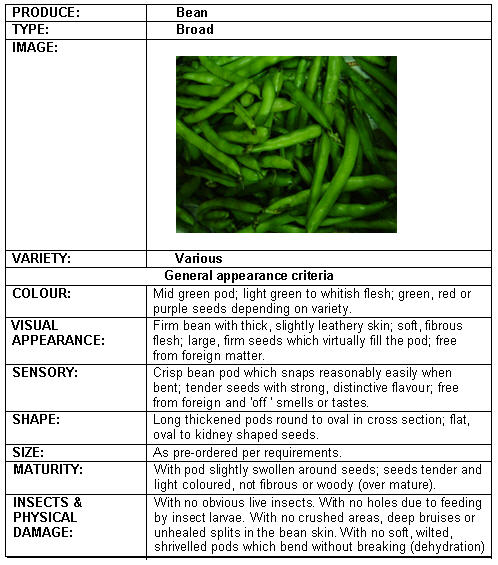 |
|
Ⓒ S. Kahumbu, Kenya |
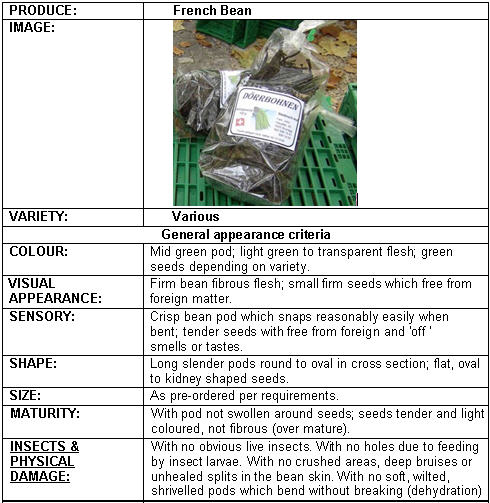 |
|
Ⓒ S. Kahumbu, Kenya |
Harvest, post-harvest practices and markets
Harvest
Dry beans are harvested when they rattle in the pod. The plant is pulled up by hand and hung from the roots. There are two main methods of bean harvesting: manual and mechanical. Small-scale farmers often hand-pick beans individually. This method allows for careful selection of ripe pods and minimizes damage to the plant. It is commonly used for specialty or high-value beans. Large-scale commercial operations employ machinery for bean harvesting. Mechanical harvesters use various mechanisms, such as reel-type or pick-up systems, to strip or pick the beans from the plants. These machines are efficient and can handle large volumes of beans quickly. Different bean varieties may require specific harvesting techniques. For example, bush beans are usually harvested by hand due to their compact growth habit, while pole beans may be harvested mechanically because they grow on climbing vines.
French beans are harvested before the pods are fully-grown. Harvest starts 7-8 weeks after sowing in early cultivars. Pods should be picked every 2-3 days, and the number of pickings is greater in climbing than in bushy cultivars. Dry beans are harvested as soon as a considerable proportion of the pods (roughly 80%) are fully mature and have turned yellow. Some cultivars tend to shatter. Usually entire plants are pulled and further dried till ready for threshing. After threshing the beans are further sun dried to estimated 12 % moisture to avoid storage problems.
Post-harvest
Solar drying of bean seeds before storage is essential. Also before storing, mix bean seeds with a) ashes or ash/chilli mixture b) diatomite (commercially available as Kensil Lagging from most hardware shops in Kenya) c) store completely dry seeds in a sealed container such as a metal or plastic bucket with air tight lid, checking regularly that no weevils are developing and closing tightly again.
Markets
Common beans holds significant value in the global market. Major global producers include Brazil, Mexico, India, China, and the United States. In Africa, key producers of common beans are DR Congo, Rwanda, Burundi, Ethiopia, Kenya, Uganda, Tanzania, Malawi, Angola, and Mozambique. The African market primarily focuses on local consumption, with approximately 40% sold in urban areas and for export. Trade between neighboring countries is significant, with Uganda being a notable supplier to Kenya, Rwanda, and Sudan. Some African countries, like Ethiopia and northern Tanzania, specialize in bean production for export to Europe, the Middle East, and other specific markets. Value-added products, such as canned beans and bean flour, cater to growing demand for convenient and nutritious food. Continuous market monitoring is essential for industry stakeholders. (Wortmann, C.S., 2006).
Ⓒ P Maundu 2014.
Nutritional value and recipes
Beans are one of the most important crops in the country and are considered the most important and basic food legume for nearly 300 million people in the developing countries. It is an excellent source of plant-based protein, making it an important addition to vegetarian and vegan diet considered as the second source of protein in most populations in eastern and southern Africa, and also used as the main source of protein in rural communities globally.
Moreover, this legume is rich in dietary fiber, which aids digestion, regulates blood sugar levels, and promotes a feeling of fullness. Fiber is also beneficial for maintaining a healthy weight and reducing the risk of chronic diseases like heart disease and type 2 diabetes. Common beans provides complex carbohydrates that release energy slowly, helping with weight management and providing sustained feelings of fullness. Beans are a good source of folate, iron, magnesium, phosphorus, and potassium. Folate is essential for red blood cell production, iron supports oxygen transport, and magnesium and phosphorus contribute to bone health. Potassium plays a vital role in maintaining healthy blood pressure levels.
(Romero et al., 2013, Hayat et al., 2014, Celmeli, et al., 2018, Kotue, et al., 2018)
Table 1: Proximate composition of 100 g of dry raw kidney beans and boiled drained without salt
Beans, kidney, dry, raw |
Beans, kidney, dry, unsoaked, boiled, drained (without salt) |
Recommended daily allowance (approx.) for adultsa |
|
Edible portion |
1 |
1 |
|
Energy (KJ) |
1280 |
491 |
9623 |
Energy(kcal)) |
305 |
117 |
2300 |
Water (g) |
12.1 |
66.3 |
2000-3000c |
Protein (g) |
20.5 |
7.9 |
50 |
Fat (g) |
2 |
0.8 |
<30 (male), <20 (female)b |
Carbohydrates |
40.6 |
15.5 |
225 -325g |
Fibre. Total dietary (g) |
21.2 |
8.1 |
30d |
Ash (g) |
3.6 |
1.4 |
|
Mineral composition |
|||
Calcium (mg) |
106 |
36 |
800 |
Iron (mg) |
6.4 |
2.1 |
14 |
Magnesium (mg) |
103 |
34 |
300 |
Phosphorus (mg) |
600 |
207 |
800 |
Potassium (mg) |
872 |
251 |
4,700f |
Sodium (mg) |
22 |
8 |
<2300e |
Zinc (mg) |
2.78 |
0.96 |
15 |
Se (mg) |
4 |
2 |
60 |
Bioactive compound composition |
|||
Vit A RE (mcg) |
1 |
0 |
800 |
Vit A RAE (mcg) |
1 |
0 |
800 |
Retinol (mcg) |
0 |
0 |
1000 |
Beta-carotene equiv. (mcg) |
6 |
2 |
600 – 1500g |
Vit D (mcg) |
5 – 15* |
||
Vit E (mg) |
9 |
||
Thiamine (mg) |
0.35 |
0.09 |
1.4 |
Riboflavin (mg) |
0.18 |
0.05 |
1.6 |
Niacin (mg) |
2.4 |
0.6 |
18 |
Folate (mcg) |
272 |
52 |
400f |
Vit B12 (mcg) |
0 |
0 |
3 |
Vit C (mg) |
0.3 |
0 |
60 |
Source (Nutrient data): FAO/Government of Kenya. 2018. Kenya Food Composition Tables. Nairobi, 254 pp. http://www.fao.org/3/I9120EN/i9120en.pdf
$ Draining the water several times leaches away water soluble nutrients significantly.
a Lewis, J. 2019. Codex nutrient reference values. Rome. FAO and WHO
b NHS (refers to saturated fat)
c https://www.hsph.harvard.edu/nutritionsource/water/
d British Heart Foundation
e FDA
f NIH
g Mayo Clinic
Recipes
1. Mushenye (beans and sweet potatoes)
(Source: Vihiga, Kenya)
Ingredients
• 1 Kg beans
• 5 large sized sweet potatoes (red variety)
• Salt to taste (optional)
Preparation
• Sort and clean the beans well
• Peel and clean the sweet potatoes
• Boil beans and sweet potatoes separately
• When ready mix and season to taste
• Mash the mixture to a soft consistency
• Serve warm with any stew or tea
2. Bean katogo
(Source: The Gishu, Mt. Elgon, Uganda)
Ingredients:
• Beans
• Matoke (Plantain)
• Tomatoes
• Onions
• Lye (traditional salt)
Procedure:
• Boil beans until they are ready.
• Peel plantains and put a layer of them in a separate pan.
• Add a layer of beans.
• Add another layer of plantain, then another layer of beans
• Add traditional salt (lye) to soften both the bananas and the beans and salt to taste.
• Cover with banana leaves. If not firm, put another pot on top. If exposed, the food can turn black.
• Cook over high heat for about 5 minutes
• Cook for a further 15 minutes over mild heat.
• Alternatively, remove the leaves and tomatoes and onions after 10 minutes of cooking. Mix completely, then, cook for a further 20 minutes.
Note: For quantities of ingredients, try different proportions and see what appeals most
3. Irio
(A recipe of the Kikuyu of Kenya)
Ingredients
200 g dried beans
100 g Green maize
60 g Stinging nettle leaves
200 g Potatoes
2 cups water
Procedure
• Select and soak the beans overnight. This significantly reduces the cooking time.
• Shell the maize and select the beans to remove unwanted particles.
• Pluck the stalks off the leaves, and then wash the leaves twice to ensure absolute removal of mud and insects. Set aside for use later.
• Mix and wash the maize and the beans together.
• Put these into a pot or saucepan, and then add water to slightly cover the food and boil until they are all cooked i.e. when the beans are soft on pressing between the fingers. If cooking by pressure cooker, pressure-cook for 20 minutes and allow pressure cooker to cool on its own.
• Add the peeled and cleaned potatoes to the maize and beans.
• Without chopping, add the leaves to the pot and continue boiling until the potatoes are soft enough to be mashed. By now the water level should have greatly reduced.
• Drain off any excess water. (This excess water can be kept aside to soften baby food.)
• Mash the food until all the potatoes are all thoroughly mashed and the food evenly mixed.
Variation:
To prepare a child’s dish from the same, eliminate the maize and mash till soft and light enough for a child. The food can be made lighter by adding the excess water drained out before mashing.
Also, stinging nettle leaves could also be substituted with pumpkin leaves or leaves of the buffalo gourd (Cucumis ficifolia - Kahurura or Kanyuria in Kenya)
4. Beans and edoodo (amaranth)
(Uganda recipe)
Ingredients
2 cups beans (dry or green)
2 bunches of Amaranthus leaves
Salt to taste
Preparation
• Select beans to ensure they are clear of any debris.
• Wash the beans and soak (if dry) overnight. This greatly reduces the cooking time.
• If beans were soaked overnight, replace soaking water and place on fire to boil.
• Allow boiling till beans are cooked, i.e. soft when pressed between fingers
• Drain any excess water, leaving about a cup.
• Wash the vegetables and place the vegetables on the beans and allow them to steam for about 15 minutes or till the vegetables are tender.
• Add salt to taste then mash the vegetables and beans together.
• Serve with sweet potato, banana, cassava, millet or preferred stew.
Variation:
You may add groundnut or simsim (sesame) paste or butter.
5. Beans in Samusoni
(Uganda recipe)
Ingredients
40 g young leaves of Colocasia esculenta (cocoyam leaves)
450 g beans (dry or fresh) (rosecoco type if available)
1 cup groundnut or simsim butter
Preparation
• Select beans to ensure they are clear of any debris.
• Wash the beans and soak (if dry) overnight. This greatly reduces the cooking time.
• If beans were soaked overnight, replace soaking water and place on fire to boil.
• Allow boiling till beans are cooked, i.e. soft when pressed between fingers
• Drain any excess water, leaving about a cup.
• Remove the petiole and veins from the vegetables then wash.
• Place the vegetables over the beans and steam till they are cooked.
• Add salt to taste, groundnut or simsim butter then mash the vegetables and the beans together.
• Serve with cassava or sweet potatoes or preferred stew.
Remark
This is a very thick bean sauce and should be eaten while warm as it becomes thicker when it cools.
| The bean seed fly, also known as seed corn maggot, resembles small houseflies. It is about 1cm long. Female flies are attracted to recently disturbed open soil, where they lay eggs, especially where there are plant residues or when large amount of manure has been applied. The maggots bore into germinating bean seeds or the cotyledons (first seed leaves) of the young plant eating them. This causes patchy emergence of seedlings. If damaged plants emerge, they are stunted, weak and fail to develop into productive plants. Pupation takes place in the soil, 2-4 cm under the soil surface. What to do:
|
| Whiteflies (Bemisia tabaci and Trialeurodes vaporariorum) Whiteflies are important pests of beans. Both the larvae and the adults pierce and suck the sap from leaves, which may cause reduced plant growth, yellowing of leaves, and wilting of the plant when present in large numbers. They produce honeydew, which may lead to growth of sooty mould on leaves and pods. Heavy growth of sooty mould reduces photosynthesis affecting plant growth. French bean pods contaminated with sooty mould are unmarketable. Control measures on beans are justified if large whitefly numbers attack the plants during the early stages of the crop. Whitefly infestations after the onset of flowering usually do not affect yield. Adults are small (1-3 mm long), with two pairs of wings that are held roof-like over the body. They resemble very small moths. What to do:
|
| Several species of bugs feed on beans. The most common in East Africa are the spiny brown bug (Clavigralla tomentosicolis), Riptortus bugs (Riptortus dentipes), the green stink bug(Nezara viridula) and the tip wilter (Anoplocnemis curvipes). Bugs suck on pods causing tiny lesions, and may cause shrivelling and rotting of the seeds, which lose viability. The whole pod may also shrivel. French bean pods showing signs of bug attack (pimples) are not marketable. Tip wilters sometimes suck the sap on shoots, causing them to wilt and turn necrotic and rot. The green stinkbug transmits a fungus to developing seeds, causing yeast spot, which is a widespread but a minor disease of beans in Africa. Bugs are difficult to control since they usually feed on a wide range of crops and are very mobile. What to do:
|
| Flower thrips (Frankliniella spp. and Megalurotrhips sjostedti) Feeding by flower thrips causes scars and blemishes on leaves and pods. Flower thrips can be found feeding on young plants. They are less than 2 mm long. As soon as the plants start flowering, however, most thrips would be found in the flower buds, flowers and on the young pods. Heavy thrips feeding causes flower abortion and flower malformation. French bean pods become scarred (having a rough silvery surface) and malformed and are not marketable. What to do:
|
| Flower or blister beetles (Mylabris oculata) The adults of the flower beetles, also known as blister beetles, feed on bean flowers (petals and / or pollen) reducing pod set. The adults are medium to large sized beetles (2-5 cm in length), usually black and yellow or black and red in colour. The immature stages (larvae) do not feed on plants. They live in the soil and eat grasshopper eggs. What to do:
|
| African bollworm and other pod borers Several caterpillars are important pests as pod borers in common beans and French beans. The most common are the African bollworm (Helicoverpa armigera) and the legume pod borer (Maruca testulalis). They feed on leaves, flowers, pods and seeds. The African bollworm caterpillars are 3 to 4 cm long. They make clean circular holes in the pods. One caterpillar may damage several pods. Caterpillars of the legume pod borer attack pods at the point of contact with other pods, leaves or the stem. They frequently web together flowers, pods and leaves with excrements.
Pod borers usually do not cause significant yield reduction in beans. However, they are quarantine pests, and are particularly important in French beans grown for export. If only 1 caterpillar is found in a consignment sent to Europe, the whole consignment may be rejected. If pod borers are found in a field, the beans harvested should be sorted very thoroughly to remove the bollworms manually.
What to do:
|
| Storage pests: Bruchids (Zabrotes subfasciatus, Acanthoscelides obtectus) Bruchids such as the bean bruchid or dry bean weevil (Acanthoscelides obtectus), and the Mexican bean weevil (Zabrotes subfasciatus) are storage pests, attacking dried beans in Africa. They are small beetles (3-5 mm) grey, brown to reddish-brown in colour. Females of the dry bean weevil lay eggs glued to the bean seeds, while females of the Mexican bean weevil lay eggs scattered between the bean seeds. Development takes place inside the bean and takes about one month before the adult emerges. The larvae feed on the seeds destroying them or reducing germination capacity. The adult emerges from the seeds leaving small round holes on the bean seeds. Heavy infestation can result in a large number of holed seeds, with adults moving across the stored beans. The dry bean weevil can attack pods in the field laying eggs on ripening pods. The Mexican bean weevil attacks only beans in storage. What to do:
|
| Bean flies also called bean stem maggots are serious pests in Africa. The adult is a tiny (about 2mm long) fly, shiny black-bluish in colour. The female fly pierces the young leaves to lay eggs and sucks the exuding sap. This leaves yellow blotches on the leaves, which are the first signs of bean fly attack and may serve as early symptom useful for monitoring the presence of this pest in the field. Maggots mine their way from the leaves down to the base of the stem, where they complete their development.
Maggot feeding destroys the tissue causing the stem to swell and split and reducing formation of lateral roots. Attacked plants produce adventitious roots in compensation. Maggots (yellow in colour) and pupae (brown or black in colour) can often be seen through the stem splits. Young seedlings and plants under stress wilt and die when attacked by bean flies. Older or vigorous plants may tolerate bean fly attack, but their growth will be stunted and their yield reduced. Damage is more severe in plants growing under poor conditions such as infertile soils and drought.
What to do:
|
| Cutworms attack young seedlings. First instars are 0.7-1 cm, later instars are 3.5-5cm long. The caterpillar emerges from the soil at night, encircles the plant with its body and cut through the stem of young plants just above ground level. They may also damage the plants underground. Cutworm damage causes plants to wilt and die. Cutworm damage is usually minor and does not normally warrant control. However, in severe outbreaks a young crop may be destroyed. What to do:
|
| Aphids (Aphis fabae) and (Aphis craccivora) The black bean aphid (Aphis fabae) and the black legume aphid (Aphis craccivora) are black to dark brown brownish in colour and winged or wingless and vary in size from 1.5 to 3.0 mm. Aphids feed by sucking plant sap. Small aphid populations may be relatively harmless, but heavily infested plants usually have wrinkled leaves, stunted growth and deformed pods. Plants, in particular young plants, may dry out and die under heavy aphid attack. Heavy attack on older plants may cause crop loss by decreasing flower and pod production. Damage may also reduce seed viability.
In addition, plants may become contaminated by honeydew produced by aphids and sooty mould growing on honeydew. French beans contaminated with honeydew and / or sooty moulds are not marketable. Aphids are also vectors of diseases, including the bean common mosaic virus. The black bean aphid is a widely distributed pest of beans. The black legume aphid usually attacks beans grown at low altitudes. What to do:
|
| Foliage beetles (Ootheca spp.; Monolepta spp.) In East Africa foliage beetles (Ootheca spp.; Monolepta spp.) are commonly found feeding on bean leaves. Foliage beetles chew small round holes in the leaves. They are about 4-7mm long. They may be a serious problem when present in large numbers or when attacking young plants. Heavy attacks may cause defoliation. Attack on young plants may reduce plant vigour, plant size and yield. The problem is more acute in fields with continuous growing of beans.
Ootheca beetles are normally not serious pest of French beans, but are an important pest of common beans in East Africa. The larvae (grubs) of foliage beetles live in the soil feeding on roots. Their feeding may cause stunted growth and premature ageing of the plants.
Grubs of weevils live in the soil feeding on roots or may bore into the stem of the bean plant causing swellings or galls, as is the case of the striped bean weevil. Plants attacked by grubs of this weevil show stunted growth and may die. The stem of the plant breaks easily during harvesting (see more below). What to do:
|
| Striped bean weevil (Alcidodes leucogrammus) Several species of snout weevils are commonly found feeding on bean leaves. Adult weevils chew the edges of the leaves cutting circular discs. Grubs of weevils live in the soil feeding on roots or may bore into the stem of the bean plant causing swellings or galls, as is the case of the striped bean weevil.
The adult of the striped bean weevil is 10-15mm long, dark brown in colour with whitish to yellowish longitudinal stripes. The females lay eggs in the soil near bean plants. Emerging grubs bore and feed inside the stem, causing cankerous swelling or galls. Fully-grown grubs are white, about 10mm long, have no less and are C-shaped. Pupation occurs in an earthen cell attached to the plant. Plants attacked by grubs of this weevil show stunted growth, lodging, and eventually may die. The stem of the plant breaks easily during harvesting. In Kenya, striped bean weevil only occurs occasionally, and to a minor extent and control measures are usually not required.
Beetles can be collected manually and destroyed. Plants damaged by the grubs can be removed and the grubs destroyed. What to do:
|
| Leafmining flies (Lyriomiza spp) Leafminers are small flies, about 1.5 mm in length. The maggot makes long, slender, white mines (tunnels) in leaves.
Severely mined leaves may turn yellow and drop. Severely attacked seedlings are stunted and may eventually die. Control measures are necessary when attack is severe, especially on young plants. What to do:
|
| Leafhoppers (Empoasca dolichi and E. lybica) They are widely distributed in Africa. Leafhoppers are small (about 2.5 mm long), slender mobile insects and green in colour. They move sideways when disturbed. Numerous leafhoppers may be seen on the underside of leaves. Their feeding on beans causes down curled leaves with yellowish margins. Eventually the whole plant may turn yellowish brown and dry-up. In Africa, leafhopper damage is usually minor and does not warrant control. What to do:
|
| Spider mites (Tetranychus spp.) Spider mites feeding on bean plants may cause reduction in plant growth, flowering, number and length of pods, and number of seeds per pod. Damage is most severe when mites attack young plants. Mite damage may be particularly severe during the dry season. What to do:
|
Information on Diseases
Common bean diseases in the tropics are:
- Common blight (Xanthomonas axonopodis pv. phaseoli)
- Fusarium root rot (Fusarium solani f. sp. phaseoli)
- Rust (Uromyces appendiculatus var. appendiculatus)
- Anthracnose (Colletotrichum lindemuthianum)
- The bean common mosaic virus (BCMV)
- Angular leaf spot (Phaeoisariopsis griseola)
- Halo blight (Pseudomonas syringae pv. phaseolicola)
- Powdery mildew (Erysiphe polygoni)
- Root-knot nematodes (Meloidogyne spp.)
| Common blight (Xanthomonas axonopodis pv. phaseoli) This disease is a constraint to bean production in Kenya. Crop losses of between 10 and 75% have been reported. The common blight produces similar symptoms on leaves, pods, stems and seeds. Small water-soaked spots are the first symptoms observed on leaves and appear within 4 to 10 days of infection. As the spots develop, the centre becomes dry and brown. The lesion is surrounded by a narrow band of bright yellow tissue. However, yellowed tissue is occasionally absent. What to do:
|
| Fusarium root rot (Fusarium solani f. sp. phaseoli), Fusarium wilt Seedlings infected with Fusarium root rot appear dwarfed. The primary leaves are often yellow, later turning necrotic and finally the seedlings wilt. Fusarium species infect bean roots when the soil is too wet, or too hot for good bean growth. The fungus survives in soil for long period. What to do:
|
| Bean rust (Uromyces appendiculatus var. appendiculatus) Rust spots (pustules) appear on all parts above the ground. They are most numerous on leaves, particularly on the underside. They are less abundant on stems and occur sparingly on pods. Initial symptoms are minute, slightly raised yellow pustules, which later become distinct circles, reddish brown in colour and surrounded by a yellow halo. The disease is spread long distance by wind. Plant to plant spread of the disease is by farm tools, insects or water splash. Severely infected leaves drop off. What to do:
|
| Anthracnose (Colletotrichum lindemuthianum) Symptoms of anthracnose can appear on any plant part. Pale brown sunken spots may appear on the cotyledons of infected seedlings. Water may spread the disease to the hypocotyl, which if girdled, kills the seedling. Lesions on leaves are dark brown. They are restricted to the veins on lower leaf surface. On stems, lesions are elongated and sunken. On the pods, the fungus produces black, sunken lesions. These lesions penetrate deep into the pods and may cause shrivelling of the young pods. Infected seed become discoloured changing to yellow through brown to black. In damp weather, the centres of anthracnose lesions become covered with a pink spore mass. The disease is seed-borne. What to do:
|
| Symptoms of bean common mosaic virus (BCMV) are cupping and twisting of leaves with a light and dark green mosaic pattern. The dark green tissue is often bubbled and/or in bands next to the veins. Affected plants produce smaller, curled pods with a greasy appearance, and yields are reduced. The virus is seed borne. It can be transmitted by several aphid species. What to do:
|
| Halo blight (Pseudomonas syringae pv. phaseolicola) The most characteristic halo blight symptoms occur on bean foliage. Initially, small water-soaked spots resembling pin pricks appear on the lower leaf surface. These spots turn brown in a few days, and the surrounding tissue gradually become yellow-green. This zone of yellowed tissue around the spot resembles a halo, hence the name of the disease. Pod lesions first appear as small water-soaked pin pricks on the pod surface. These lesions gradually enlarge to form dark sunken spots of various sizes. A whitish bacterial ooze appears on the spots when wet. Halos do not develop around pod lesions. Pod lesions are especially important to the French bean industry because they make the bean pod unacceptable to fresh market and processors. On dry beans, pod lesions are of less importance because the beans are shelled before marketing. When infected seed is used, the primary leaves of seedlings show interveinal chlorosis, suggestive of mosaic virus infection. What to do:
|
| Angular leaf spot (Phaeoisariopsis griseola) Symptoms consist of small dark brown spots with angular edges and are often numerous to give the foliage a checker-board appearance. The spots may increase in size, join together, and cause yellowing and necrosis of the affected leaves. This may lead to premature defoliation. When humid, the fungus produces a grey mould on the lower surface of the spots. Infected pods have brown blotches. The disease is favoured by high moisture and moderate temperatures (20-25°C). The disease is seed-borne.
What to do:
|
| Powdery mildew (Erysiphe polygoni) A white powdery mould appears on the upper leaf surfaces. Severely diseased leaves turn yellow and die. Leaf petioles, stems and pods can also be affected. What to do:
|
| Root-knot nematode (Meloidogyne incognita, M. javanica) They cause stunting and yellowing of plants with a tendency to wilt in hot weather. If infested plants are pulled out from the soil, the roots can be seen to be distorted, swollen and bearing knots of various sizes. Infested roots under severe infestation decay.
These knots should not be confused with legume nodules, which are normally small and round, and are attached to the outside of the roots, whereas swellings of root-knot nematodes are within the body of the root. When active nodules are sliced, they are pinkish in colour. What to do:
|
Contact Information
- Corner Shop Nairobi:cornershop@africaonline.co.ke, +254 (0) 0716 905 486, (20) 2712268/9
- Green Dreams: info@organic.co.ke +254 (0) 724 781 971/ 0722 562 717001
- Horticultural Crops Directorate: info@agricultureauthority.go.ke, +254 20 2536869, 0722 200 556
- Kalimoni Greens: www.kalimonigreens.com , +254 (0) 708 278 273
- Karen Provision Stores:kps@nbi.ispkenya.com +254 20 882 252, 0736 371 437
- Muthaiga Green Grocers, Nairobi
- Nakumatt Supermarket: info@nakumatt.net, +254 (0) 733 632 130, 0722 204 931, (20) 3599991-4
- Horticultural Research Institute, Thika: director.hri@kalro.org. +254 (20) 2055038,
- Zuchinni Green Grocers, Nairobi. +254 (20) 2215067
References
1. Allen, D. J., Ampofo, J. K. O. and Wortmann, C. S. (1996). Pest, diseases and nutritional disorders of the common bean in Africa. A field guide. A CIAT/CTA publication. (ISBN: 958 9439 55 1)
2. CABI (2005). Crop Protection Compendium, 2005 Edition. (c) CAB International Publishing. Wallingford, UK. www.cabi.org
3. East African Seed Co. Ltd. Africa's Best Grower’s Guide www.easeed.com
4. Elwell, H. and Maas, A. (1995). Natural pest and disease control. Natural farming Network. Zimbabwe. (ISBN: 0 7974 1429 0
5. Fruits and Vegetables Technical Handbook. Published by The Ministry of Agriculture and rural Development. P.O. Box 30028, Nairobi, Kenya. Available from AIC, Kabete, Nairobi
6. Latham, P. and Konda ku Mbuta, A.K. (2006) Useful Plants of Bas-Congo Province, Democratic Republic of Congo. 2nd Edition, Mystole Publications, Canterbury, 276
7. Maundu, M. E. (1997). Control of the black bean aphid, Aphid fabae Scop. Using neem based insecticides on French beans in Kenya. Report for GTZ-IPM-Horticulture Project. 1997. 57 pp.
8. Graham, P. H., & Ranalli, P. (1997). Common bean (Phaseolus vulgaris L.). Field Crops Research, 53(1-3), 131-146.
9. Nderitu, J. H., Buruchara, R. A. and Ampofo (1997). Integrated pest management for beans. African Highlands Initiative.
10. Nutrition Data www.nutritiondata.com.
11. PIP Technical Itinerary French Beans. www.coleacp.org/pip
12. Phaseolus vulgaris L. in GBIF Secretariat (2021). GBIF Backbone Taxonomy. Checklist dataset https://doi.org/10.15468/39omei accessed via GBIF.org on 2021-12-17.
13. Maundu, P. (2006). Food list of plants in Malawi and Mozambique. Unpublished.
14. Seif, A.A., Varela, A.M., Loehr, B. and Michalik, S. (2001). A Guide to IPM in French Beans Production with Emphasis on Kenya. pp. 88. ICIPE Science Press, Nairobi, Kenya. (ISBN: 92 9064 142 8
15. Tindall, H. D. (1983). Vegetables in the tropics. Macmillan, London and Basingstoke. 533 pp. (ISBN: 0 333 24268 8)
Information Source Links
- Allen, D. J., Ampofo, J. K. O. and Wortmann, C. S. (1996). Pest, diseases and nutritional disorders of the common bean in Africa. A field guide. A CIAT/CTA publication. (ISBN: 958 9439 55 1)
- CABI (2005). Crop Protection Compendium, 2005 Edition. © CAB International Publishing. Wallingford, UK. www.cabi.org
- East African Seed Co. Ltd. Africa's Best Grower^s Guide www.easeed.com
- Elwell, H. and Maas, A. (1995). Natural pest and disease control. Natural farming Network. Zimbabwe. (ISBN: 0 7974 1429 0
- Fruits and Vegetables Technical Handbook. Published by The Ministry of Agriculture and rural Development. P.O.Box 30028, Nairobi, Kenya. Available from AIC, Kabete, NAirobi
- Maundu, M. E. (1997). Control of the black bean aphid, Aphid fabae Scop. Using neem based insecticides on French beans in Kenya. Report for GTZ-IPM-Horticulture Project. 1997. 57 pp.
- Nderitu, J. H., Buruchara, R. A. and Ampofo (1997). Integrated pest management for beans. African Highlands Initiative.
- Nutrition Data www.nutritiondata.com.
- PIP Technical Itinerary French Beans. www.coleacp.org/pip
- Seif, A.A., Varela, A.M., Loehr, B. and Michalik, S. (2001). A Guide to IPM in French Beans Production with Emphasis on Kenya. pp. 88. ICIPE Science Press, Nairobi, Kenya. (ISBN: 92 9064 142 8
- Tindall, H. D. (1983). Vegetables in the tropics. Macmillan, London and Basingstoke. 533 pp. (ISBN: 0 333 24268 8)
- https://divercitytimes.com/agriculture/crops-and-livestock/dry-beans.php#top-country-production-of-dry-bean
Review Process
Patrick Maundu, James Kioko, Charei Munene, Monique Hunziker, March 2024.

